Pea gravel walkways offer an affordable and versatile solution for creating beautiful garden paths that enhance any outdoor space. These small, rounded stones provide excellent drainage while maintaining a natural, rustic charm that complements various design styles from traditional to contemporary settings. Unlike rigid materials like pavers, pea gravel's fluid nature allows for creative curves and organic shapes while requiring minimal maintenance. Whether you're seeking a formal garden pathway or a casual cottage-style route, pea gravel provides the foundation for stunning walkway designs that combine functionality with aesthetic appeal in any landscape setting.
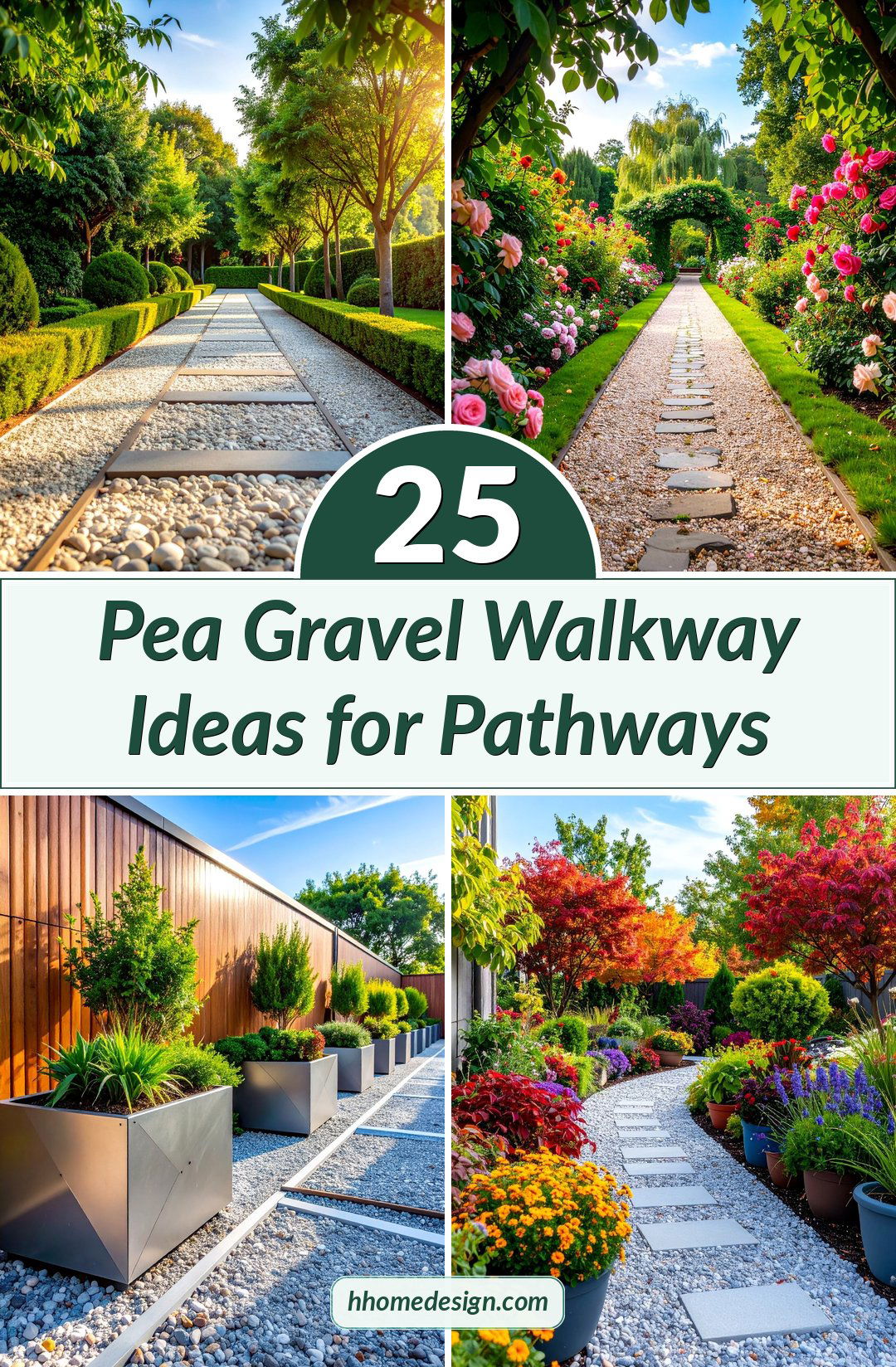
1. Classic Cottage Garden Pea Gravel Walkway with Natural Stone Edging
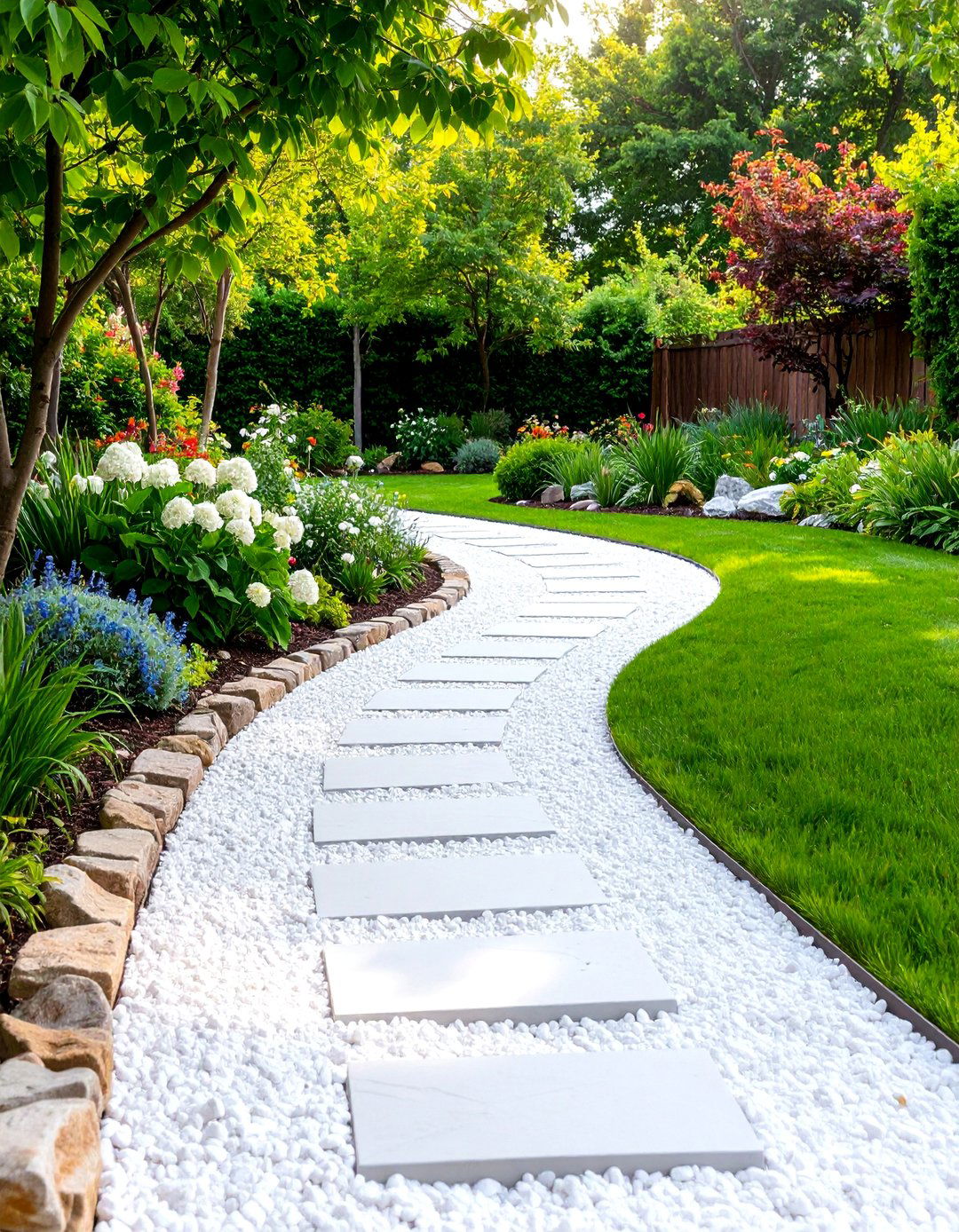
This timeless design features white pea gravel contained by large cane creek stones that create a natural stone border edging. The pathway curves gently through landscaping fabric, allowing for organic movement that mimics traditional English cottage gardens. Natural stone edging provides rustic charm while effectively containing the gravel within defined boundaries. The curved design creates visual interest as it winds from porch steps to garden areas, offering both practical foot traffic solutions and aesthetic appeal. The landscaping fabric underneath prevents weed growth while the natural stone borders require minimal maintenance. This design works beautifully in both formal and informal garden settings, providing a sophisticated yet approachable walkway that enhances cottage-style landscaping with its blend of natural materials and functional design elements.
2. Modern Zen Pea Gravel Walkway with Metal Edging

Metal edging provides an ultra-modern and durable containment system that develops a weathered rust color over time, adding character to the design. This contemporary approach features clean lines and geometric patterns created with steel or aluminum edging that contrasts beautifully with the organic texture of pea gravel. The design incorporates raked patterns in the gravel that create visual texture and symbolic meaning. Minimalist plantings of ornamental grasses or architectural shrubs complement the modern aesthetic. The metal edging maintains sharp, precise boundaries while the gravel surface provides excellent drainage and low maintenance requirements. This style suits contemporary homes and urban gardens where clean, sophisticated design elements create a calming zen-like atmosphere for meditation and relaxation.
3. Curved Pea Gravel Walkway with Integrated Stepping Stones
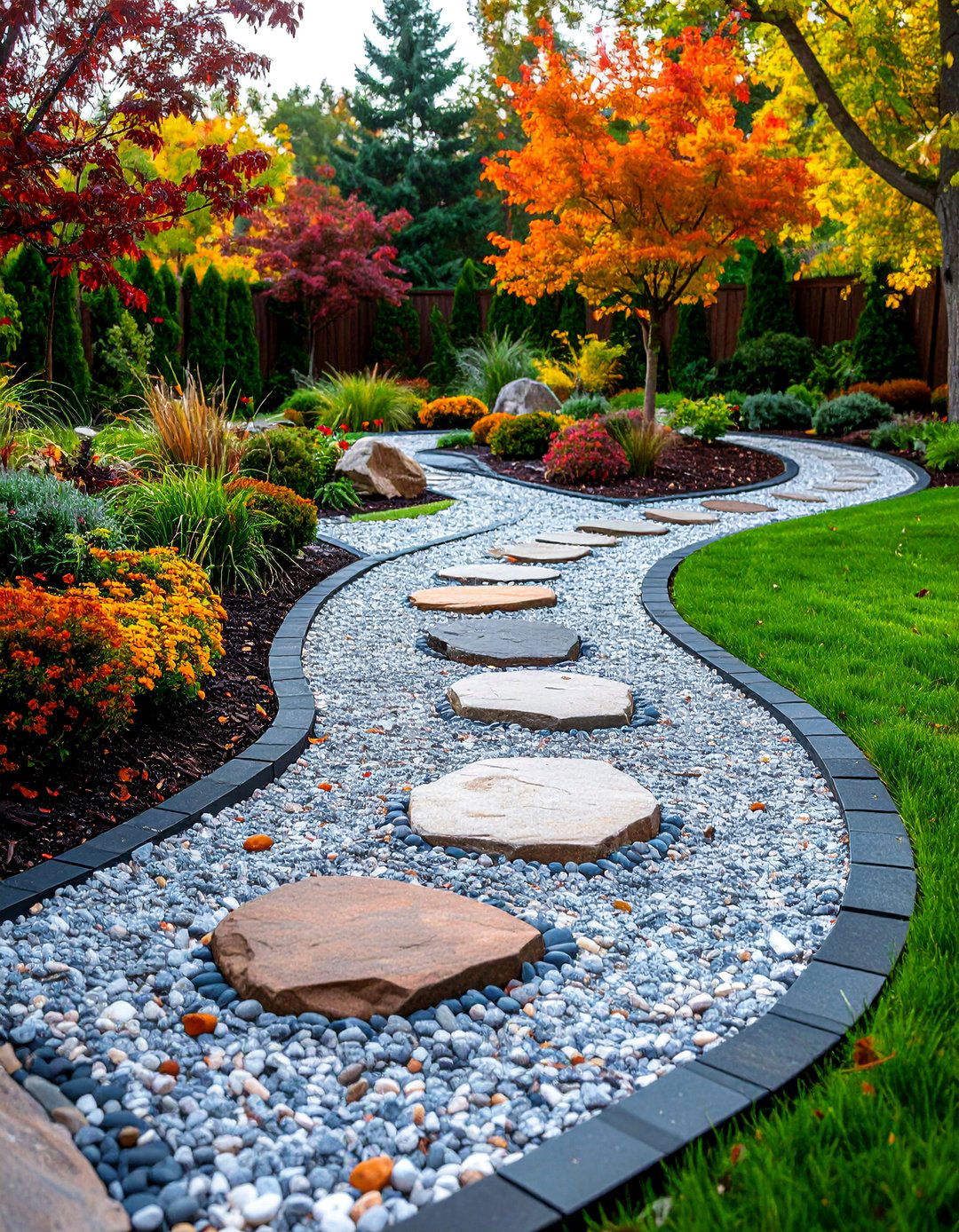
Curved designs allow for twisty, organic walkways that don't require cutting stones, making them easier to install than rigid materials. This design combines smooth pea gravel with strategically placed stepping stones that provide stable footing while maintaining the natural flow. Flagstone or precast concrete pavers are nestled into the gravel surface on a layer of sand for stability. The stepping stones should be spaced according to natural stride patterns for comfortable walking. Curved borders using flexible edging materials guide the eye through the landscape while the varied textures create visual interest. This approach works perfectly for connecting different garden areas while providing both functionality and beauty through the combination of smooth gravel surfaces and solid stepping elements.
4. Traditional Brick-Edged Pea Gravel Walkway
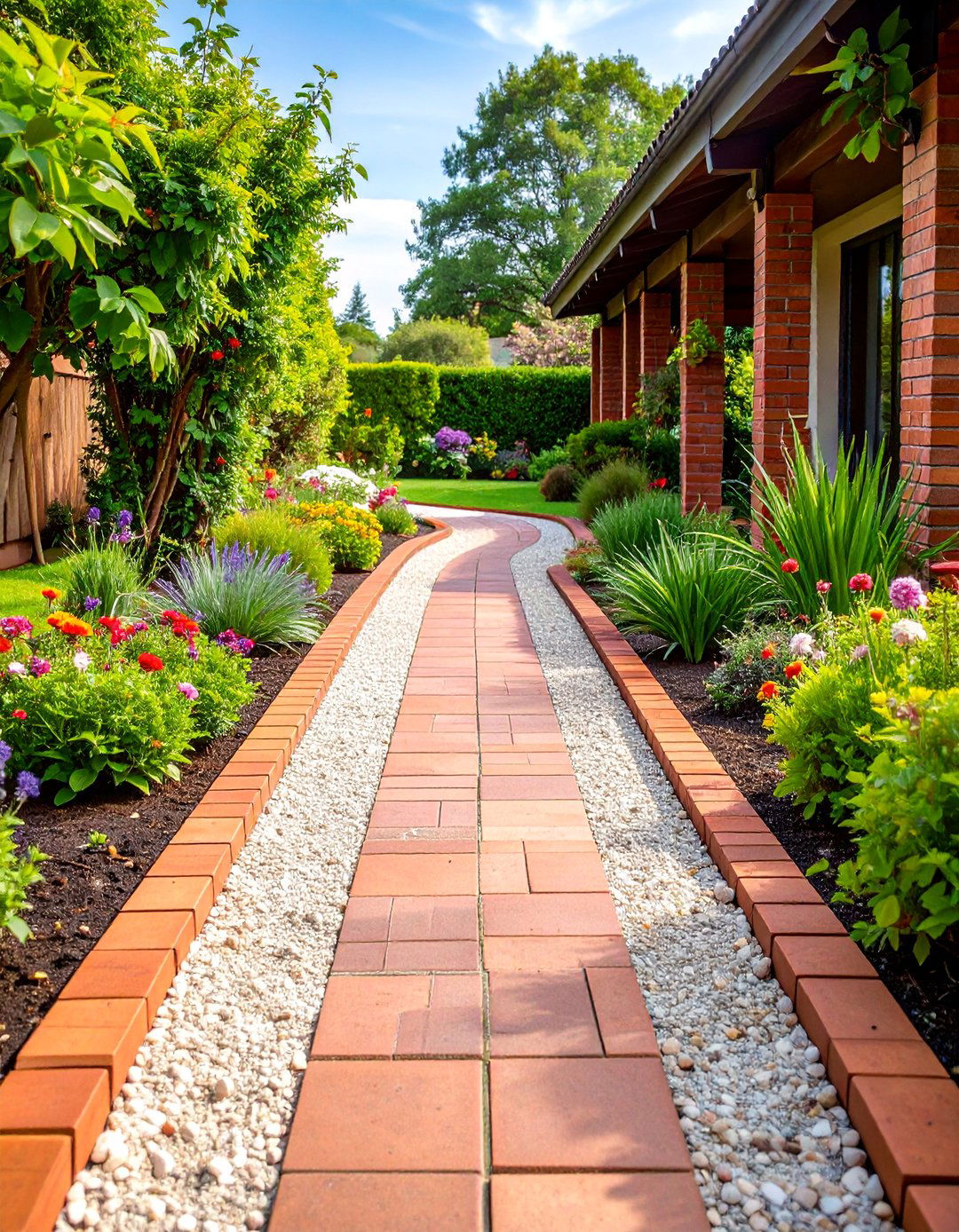
Traditional homes often call for brick edging that provides a classic, timeless appearance. This design features red clay bricks laid end-to-end along pathway edges, creating formal definition while maintaining warm, traditional appeal. The brick edging provides sturdy containment for pea gravel while offering excellent durability and weather resistance. Reclaimed bricks can be used for an authentic, aged appearance that adds character to the garden. The neutral tones of pea gravel complement the earthy red brick tones beautifully. This style works exceptionally well with colonial, farmhouse, and traditional architectural styles. The formal lines created by brick edging provide structure while the loose gravel surface maintains a softer, more natural walking experience than solid paving materials.
5. Solar-Lit Pea Gravel Walkway for Evening Ambiance
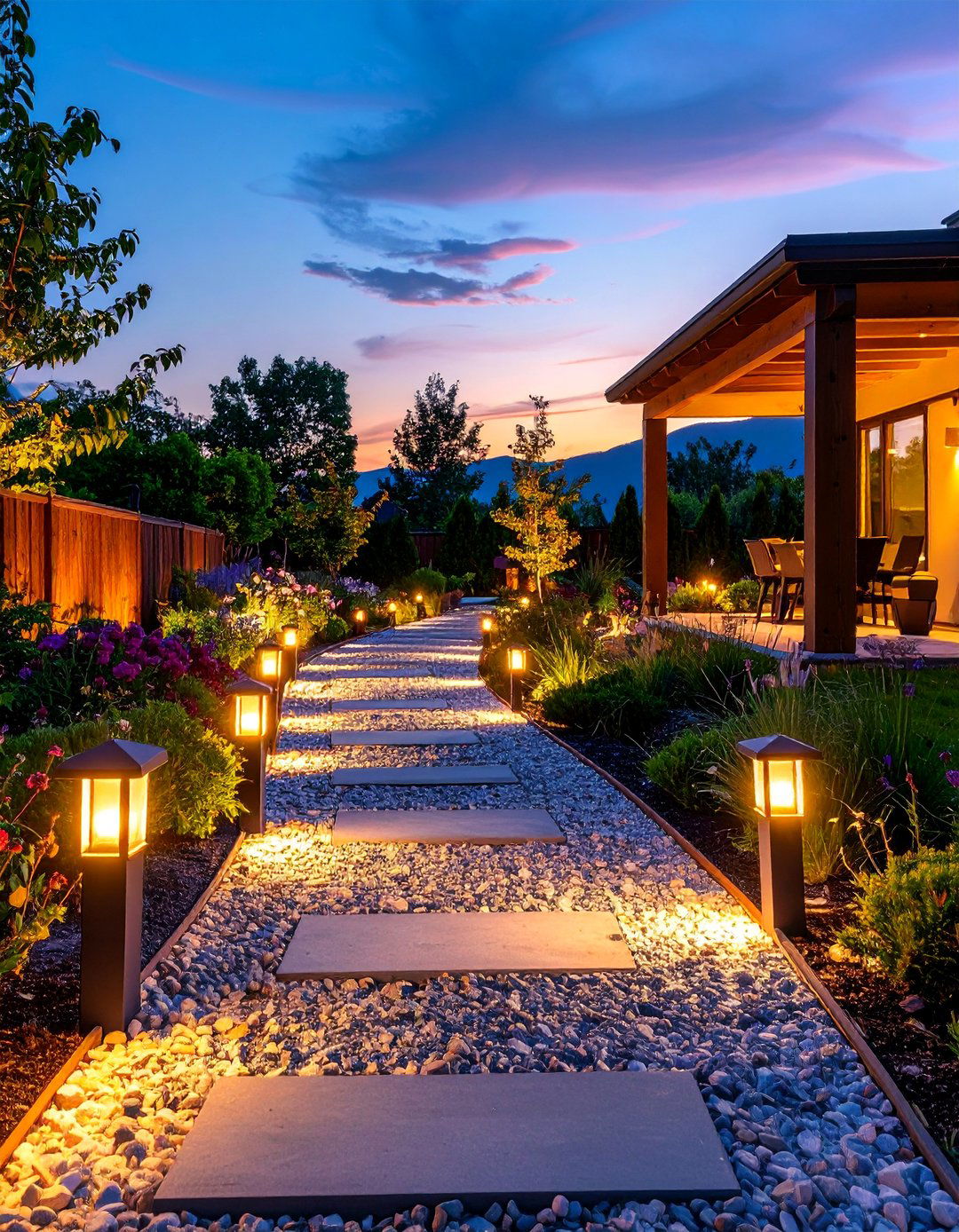
Solar-powered path lights provide an eco-friendly lighting solution that enhances safety and usability after dark. This design incorporates LED solar lights strategically placed along pathway edges to create dramatic evening illumination. Bollard lights provide substantial lighting presence while LED strip lights along edging create modern appeal. The lighting highlights the texture and patterns of the gravel surface while providing safe navigation during nighttime hours. Battery-powered solar fixtures eliminate the need for electrical wiring, making installation simple and cost-effective. Different lighting styles can be used, from traditional lantern-style fixtures to contemporary geometric shapes. This design transforms ordinary pea gravel walkways into enchanting evening focal points that extend garden enjoyment well beyond daylight hours.
6. Mediterranean-Style Pea Gravel Walkway with Lavender Borders
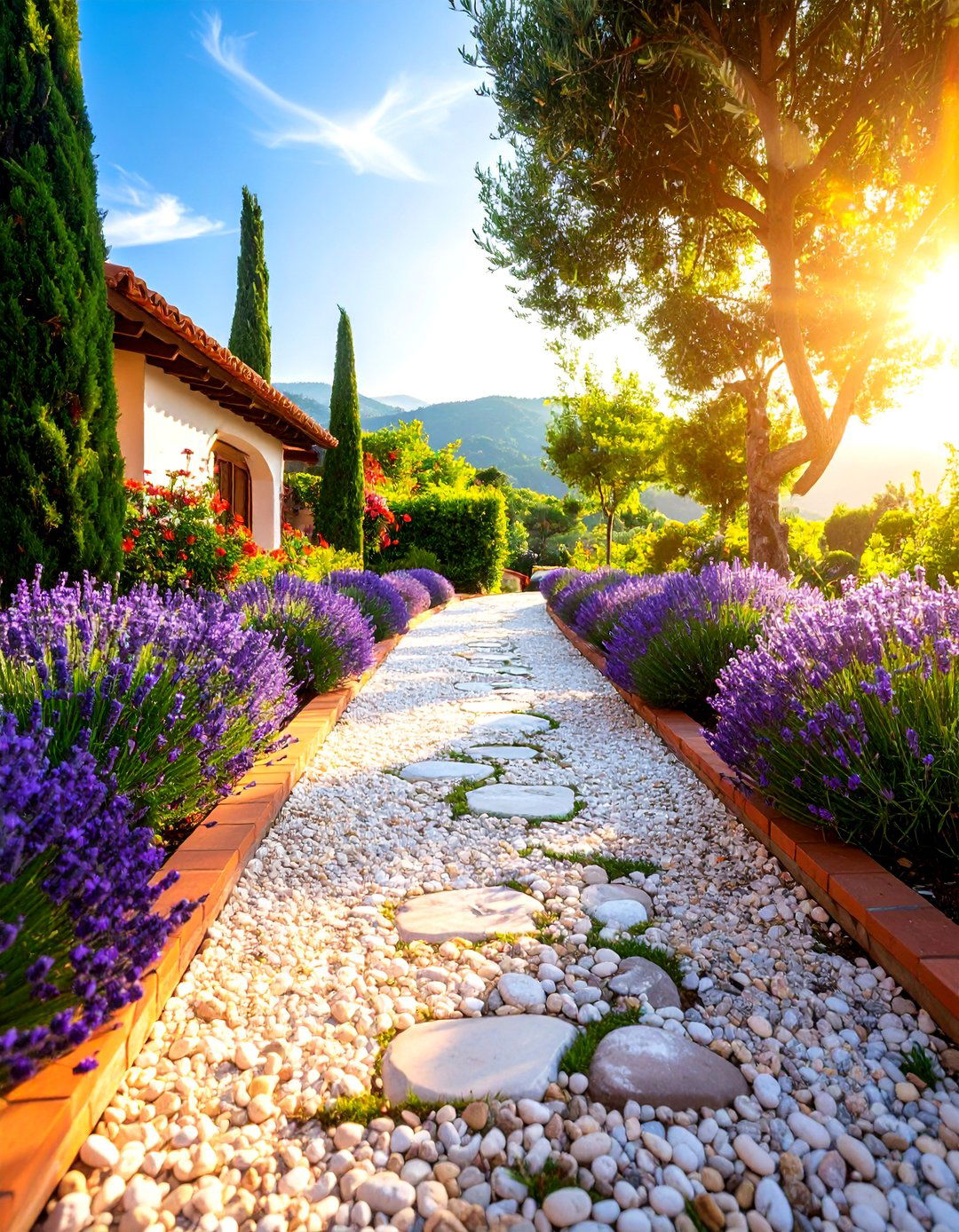
This design captures the essence of Mediterranean gardens through aromatic lavender plantings that border smooth pea gravel pathways. Flowering perennials such as lavender provide color and fragrance while complementing the neutral tones of pea gravel. Terra cotta or natural stone edging maintains the Mediterranean theme while containing the gravel surface. The purple-blue lavender blooms create stunning contrast against neutral gravel tones, while the plant's drought tolerance makes it ideal for low-maintenance landscaping. Olive trees or other Mediterranean plants can be incorporated nearby to enhance the regional theme. The combination of aromatic plantings and textured gravel surfaces creates a sensory-rich garden experience. This style works beautifully in sunny locations and suits contemporary or traditional Mediterranean-inspired home designs with its emphasis on natural materials and drought-tolerant plantings.
7. Japanese-Inspired Pea Gravel Walkway with Raked Patterns
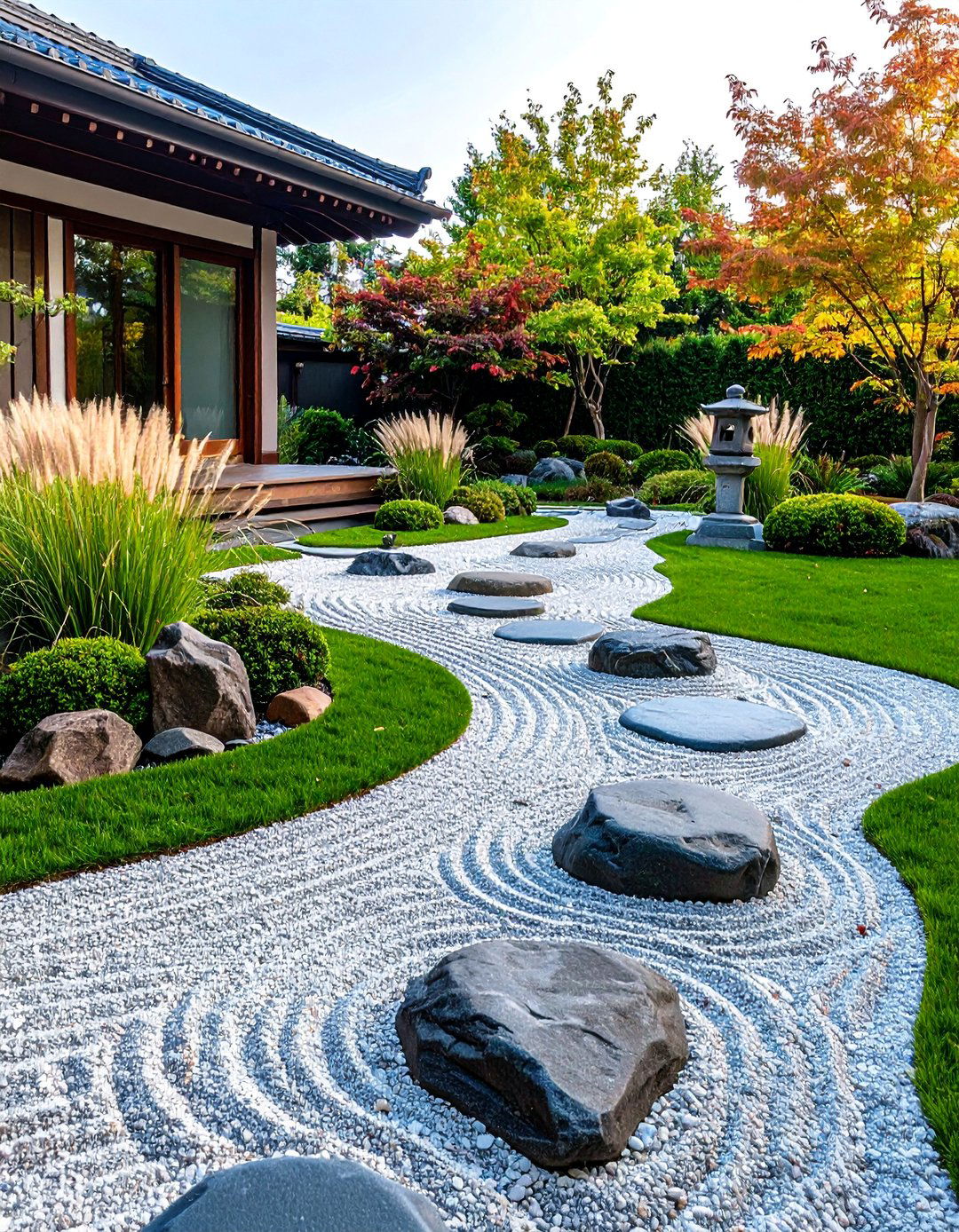
Pea gravel serves as an excellent medium for creating raked patterns that represent water and add meditative qualities to garden spaces. This design incorporates traditional Japanese garden principles through carefully raked patterns in the gravel surface. Modern Japanese designers often use pea gravel between stepping stone islands, adapting traditional concepts for contemporary functionality. The walkway features geometric or flowing patterns that can be changed regularly as part of meditative maintenance practices. Simple plantings of ornamental grasses, bamboo, or carefully pruned shrubs complement the minimalist aesthetic. Stone lanterns or Buddha statuary can serve as focal points. This design creates a peaceful, contemplative atmosphere while providing practical pathway function through spaces where tranquility and mindfulness are desired priorities.
8. Rustic Woodland Pea Gravel Walkway with Log Edging

Natural log edging creates a rustic, woodland-inspired design perfect for cabin-style homes or naturalistic garden settings. Reclaimed timber provides authentic, aged appearance while offering effective gravel containment. Pressure-treated lumber or naturally rot-resistant cedar logs are partially buried to create stable borders that blend seamlessly with woodland environments. This design works exceptionally well in shaded garden areas where moss and ferns can be encouraged to grow alongside the pathway. The organic curves of natural wood complement the informal nature of pea gravel surfaces. Native woodland plants like hostas, wild ginger, or native sedges can be planted alongside the walkway. This style creates an authentic forest path feeling while providing stable, well-drained walking surfaces that handle foot traffic effectively in natural garden settings.
9. Formal Geometric Pea Gravel Walkway with Boxwood Hedging
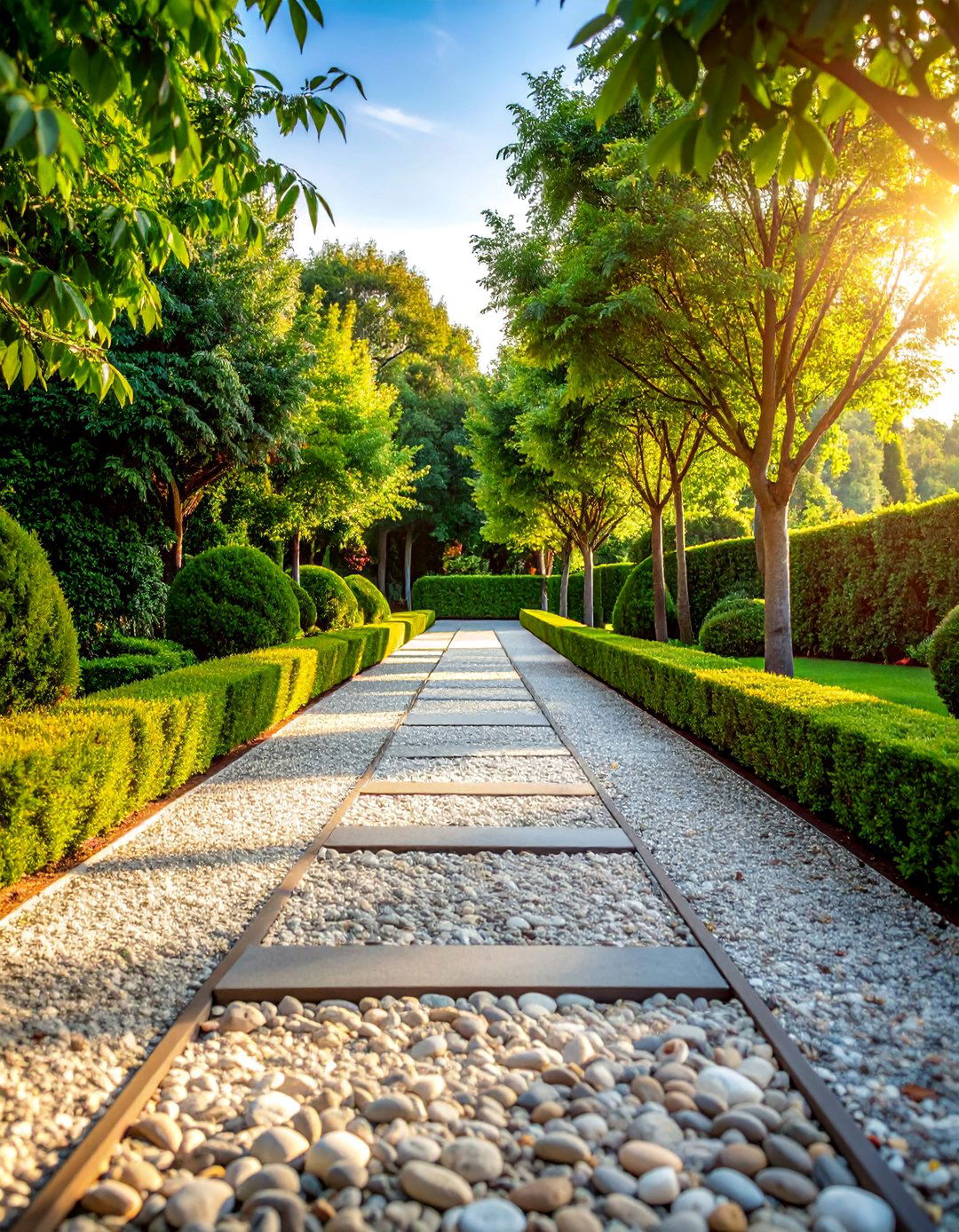
This sophisticated design creates formal garden elegance through precise geometric layouts bordered by carefully manicured boxwood hedges. Formal boxwood hedges create structured garden spaces while pea gravel provides practical surface material. The contrast between the soft, loose texture of gravel and the rigid, clipped lines of boxwood creates striking visual appeal. Geometric patterns can include straight lines, gentle curves, or more complex shapes depending on garden size and style preferences. The evergreen nature of boxwood provides year-round structure while requiring regular trimming to maintain crisp lines. This design suits formal garden styles, estate properties, and traditional landscape designs where structure and elegance are desired. Metal or stone edging beneath the hedge line ensures clean separation between planted areas and gravel surfaces.
10. Colorful Mixed-Size Pea Gravel Walkway Design
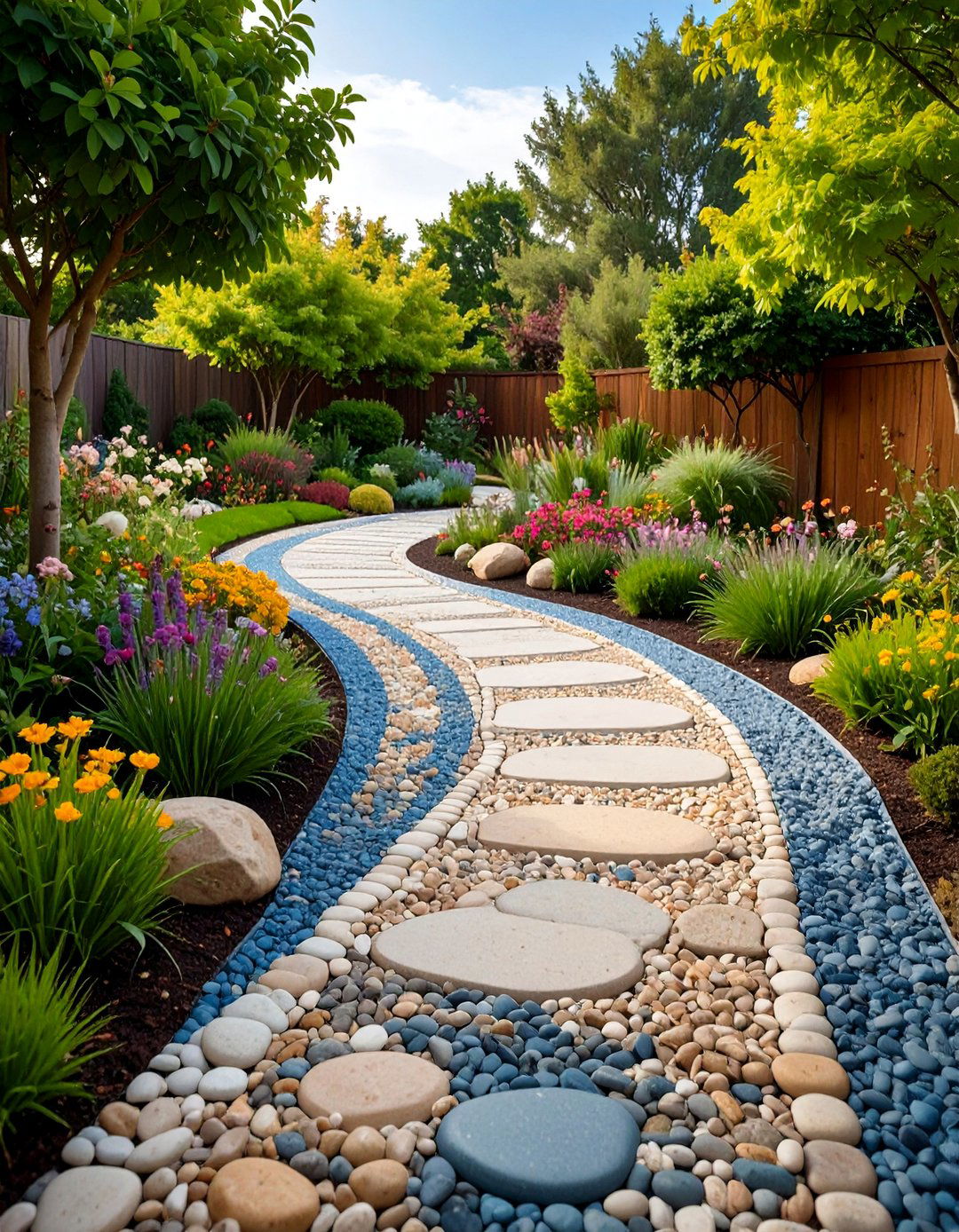
Pea gravel comes in a whole range of earthy colors, allowing for creative design possibilities. This design incorporates different colored pea gravels or mixed sizes to create patterns, borders, or transitional zones along the walkway. Colors might include traditional gray, warm brown, cream, or even darker charcoal tones arranged in stripes, geometric patterns, or gradual transitions. Different sizes of gravel can be used to create texture variations while maintaining the overall design cohesion. Crushed granite or other decorative stones can be mixed with pea gravel for additional visual interest. This approach allows for highly personalized pathway designs that reflect individual style preferences while maintaining the practical benefits of gravel surfaces. The color and size variations create dynamic visual movement that guides visitors through garden spaces with artistic flair.
11. Pea Gravel Walkway with Integrated Raised Planting Beds

This multifunctional design combines pathway utility with gardening space through raised planting beds integrated directly into the walkway design. Pea gravel can provide designated spaces for plants while offering excellent drainage for healthy root development. Stone, brick, or wood-bordered raised beds are positioned strategically along pathway edges or as central focal points. The beds can house seasonal flowers, herbs, vegetables, or ornamental plants depending on personal preferences and garden goals. The gravel surface provides clean walking areas while the raised beds offer improved soil drainage and easier plant maintenance. This design maximizes garden utility in smaller spaces while creating attractive, functional landscapes. The combination of hardscape and planted areas creates visual interest and seasonal variety while maintaining practical pathway access through garden areas.
12. Wide Pea Gravel Walkway with Central Planting Strip
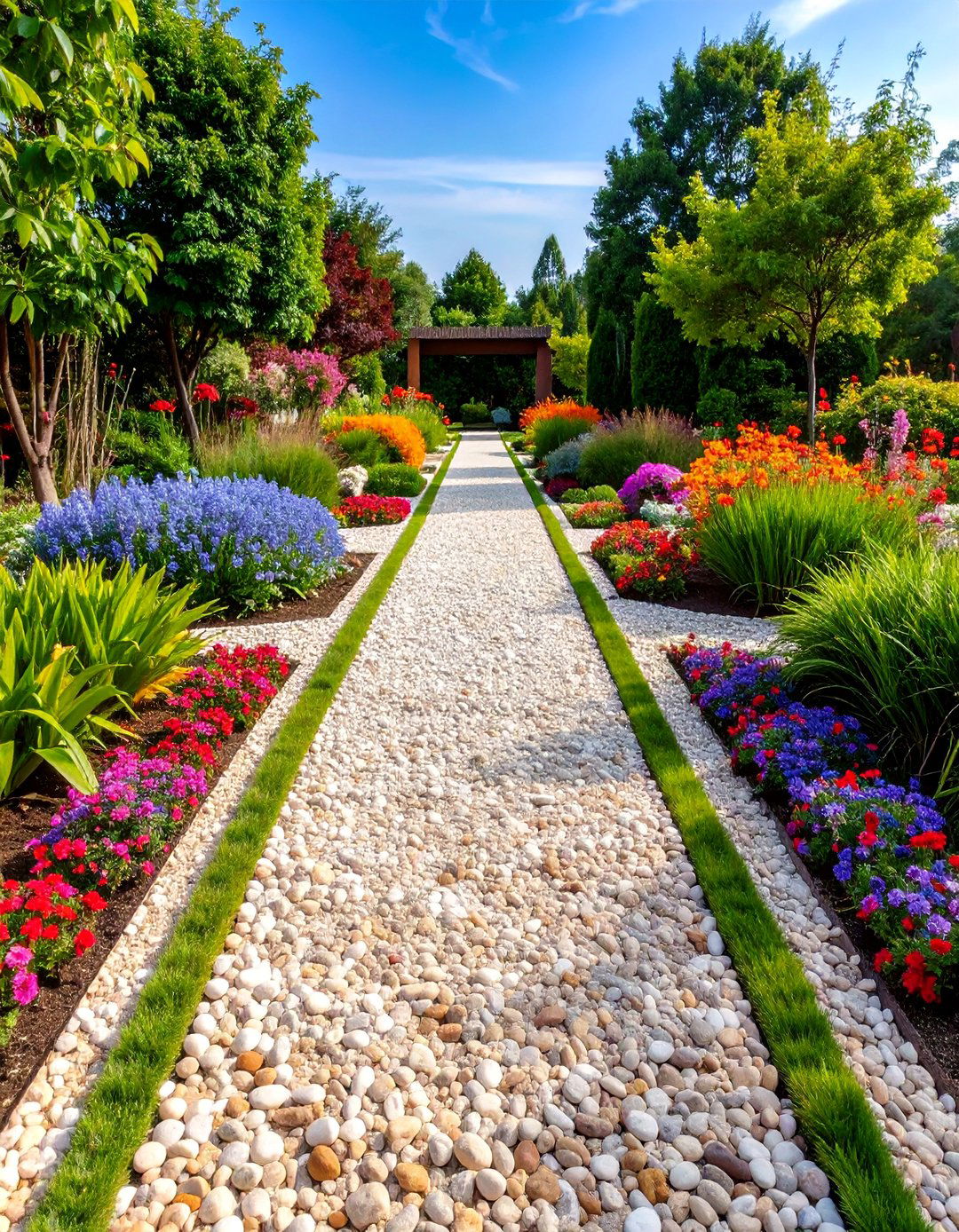
This generous walkway design features a wide gravel surface with a planted median strip running down the center, creating an impressive garden entrance or main pathway. Concrete channels can be cut into gravel surfaces and planted with succulents or other appropriate plants. The central planting strip can accommodate ornamental grasses, seasonal flowers, or low-growing perennials that add color and texture without obstructing foot traffic. Side pathways allow comfortable walking while the central planted area provides visual interest and seasonal variety. This design works particularly well for main entrance pathways or as primary garden circulation routes. The wide format accommodates multiple people walking side-by-side while the central plantings create a formal, impressive appearance. Appropriate drainage ensures healthy plant growth while maintaining gravel surface stability.
13. Minimalist Modern Pea Gravel Walkway with Concrete Edging
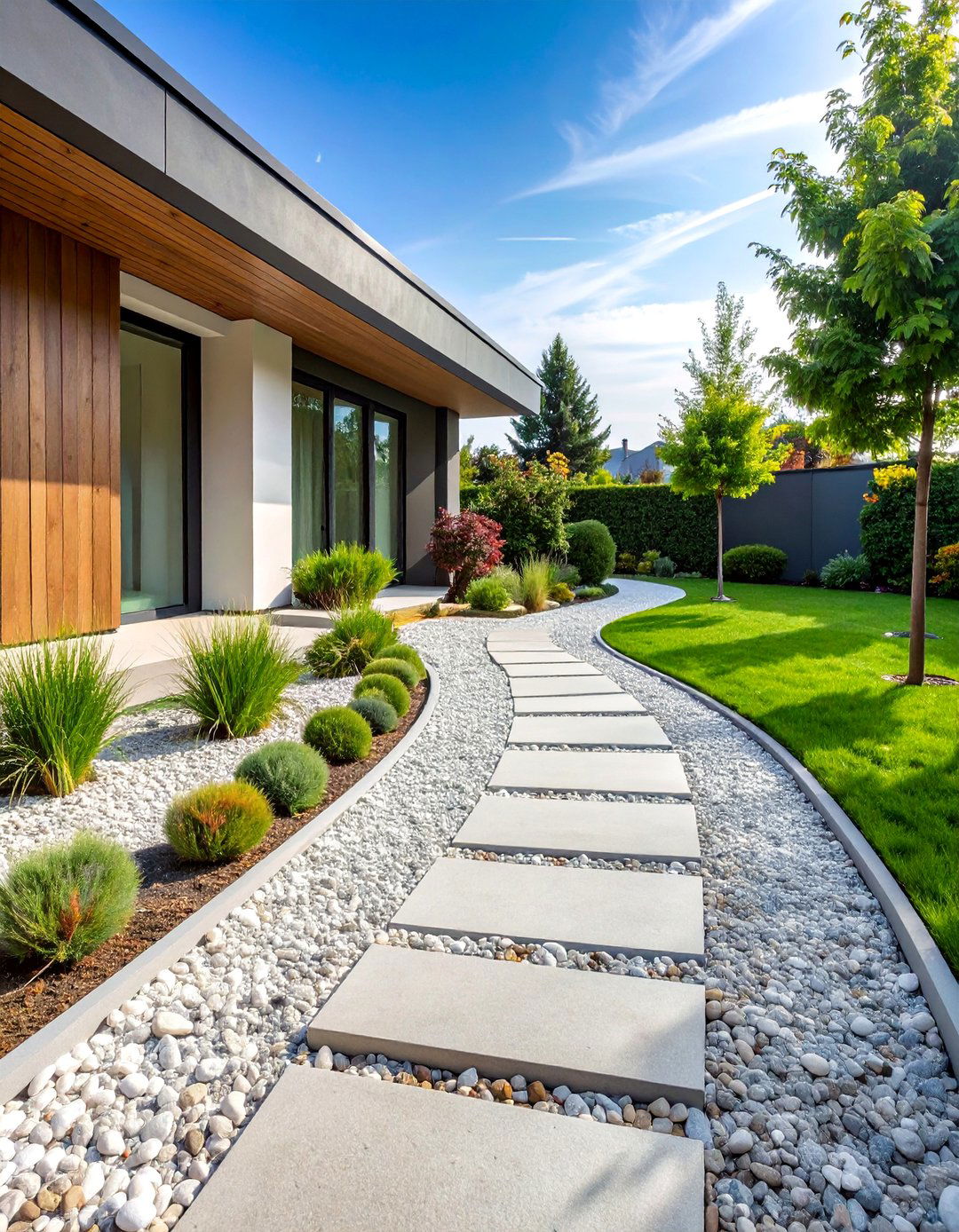
Clean concrete edging creates sophisticated modern appeal while providing permanent, low-maintenance pathway definition. Concrete paths with gravel channels create contemporary design elements suitable for modern landscaping. This design features poured concrete borders that create crisp, geometric lines contrasting beautifully with the organic texture of pea gravel. The concrete can be left natural gray, stained for color variation, or textured for additional visual interest. This style suits contemporary and modernist home designs where clean lines and minimal maintenance are priorities. The permanent nature of concrete edging eliminates ongoing border maintenance while providing excellent gravel containment. Architectural plantings like ornamental grasses or structural shrubs complement the modern aesthetic. This design creates sophisticated, professional-looking pathways that enhance contemporary landscape designs with minimal ongoing maintenance requirements.
14. Cottage-Style Pea Gravel Walkway with Mixed Perennial Borders
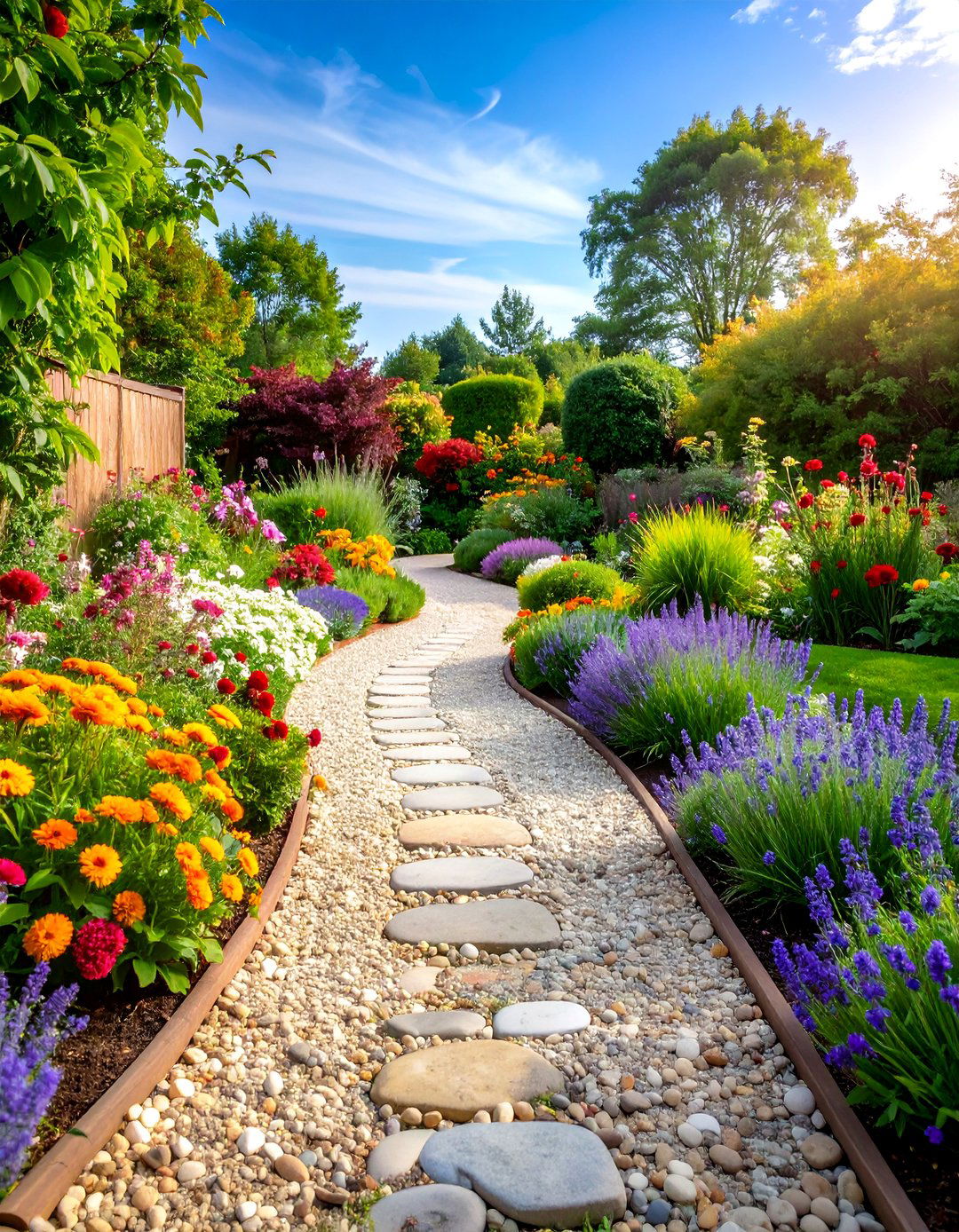
This charming design captures informal cottage garden appeal through mixed perennial plantings that create colorful, textured borders alongside pea gravel pathways. Low-growing ground covers like creeping thyme or sedum provide complementary textures while maintaining garden cohesion. The plantings can include a mixture of flowering perennials, herbs, and ornamental grasses that provide seasonal interest and natural, informal appearance. This style encourages plants to spill slightly onto pathway edges, creating soft transitions between planted areas and walking surfaces. The informal nature allows for creative plant combinations and seasonal changes that keep the garden interesting throughout growing seasons. This design works beautifully with farmhouse, cottage, or informal garden styles where natural abundance and relaxed beauty are desired over formal precision.
15. Pea Gravel Walkway with Natural Fieldstone Edging

Natural stone edging provides durability and classic appearance while being quite heavy and requiring careful installation. This design utilizes locally sourced fieldstone or natural rock pieces to create irregular, organic pathway borders that blend seamlessly with natural landscapes. The varied sizes and shapes of natural stones create visual texture while providing effective gravel containment. This style works exceptionally well in naturalistic garden settings, woodland gardens, or properties with existing stone features. The irregular nature of fieldstone creates informal, welcoming pathways that appear to have developed naturally over time. Large rocks should vary in size and be arranged asymmetrically to maintain natural appearance. This design requires minimal maintenance once established and improves with age as moss and weathering add character to stone surfaces.
16. Curved Pea Gravel Walkway with Ornamental Grass Accents
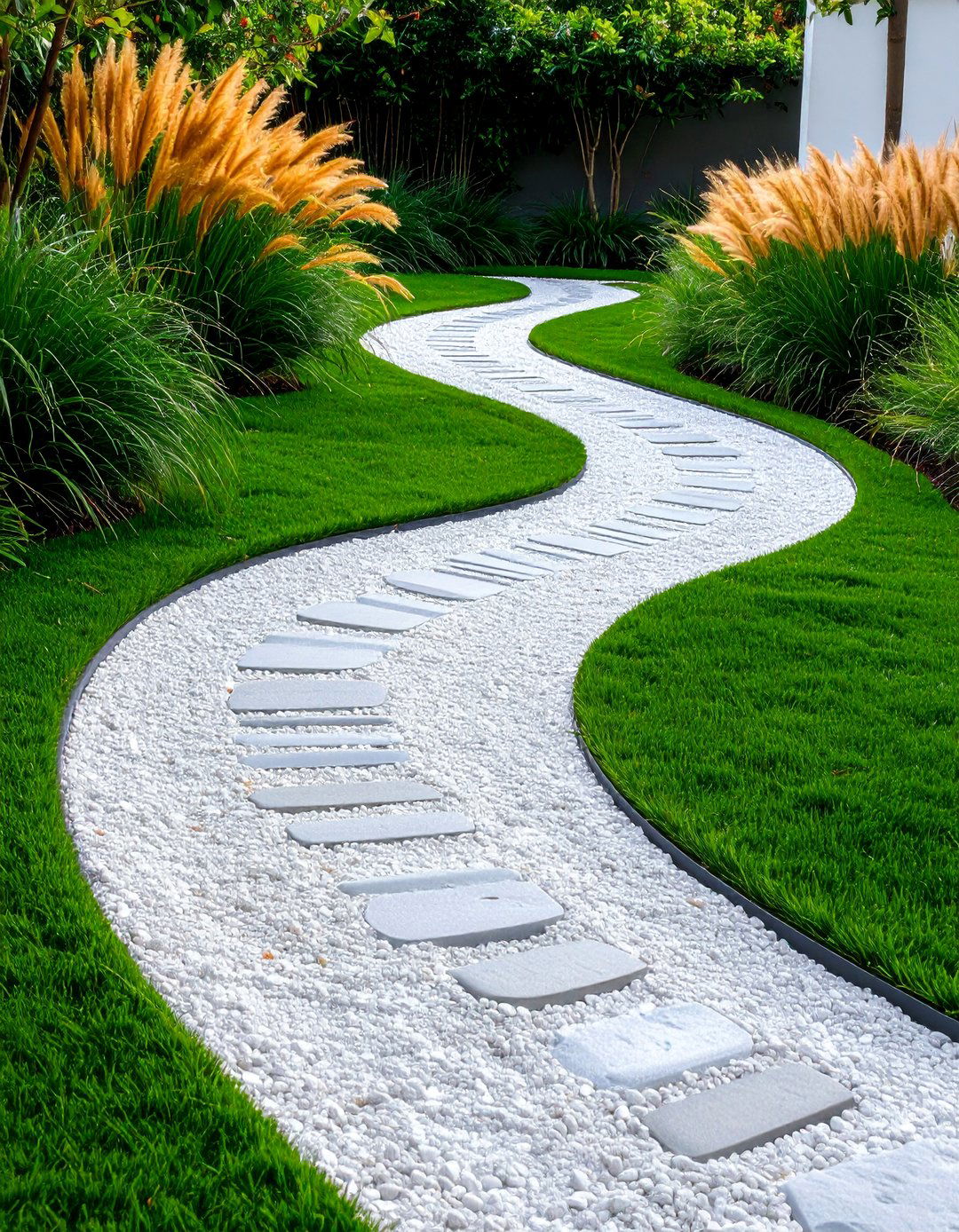
Curved pathways can be created using garden hoses to perfect desired shapes before final installation. This design features flowing curves bordered by ornamental grasses that provide seasonal interest and natural movement. Grasses like fountain grass, feather reed grass, or Japanese forest grass create textural contrast while requiring minimal maintenance. The curved pathway design guides visitors through garden spaces while the grasses provide privacy screening and habitat for beneficial wildlife. Flexible edging materials accommodate the curved design while grasses soften the transition between pathway and surrounding landscape. This style works beautifully in contemporary and naturalistic garden settings where movement and seasonal interest are desired. The combination of flowing pathway curves and graceful grass movement creates dynamic, living landscape features that change with seasons and weather.
17. Pea Gravel Walkway with Integrated Water Feature
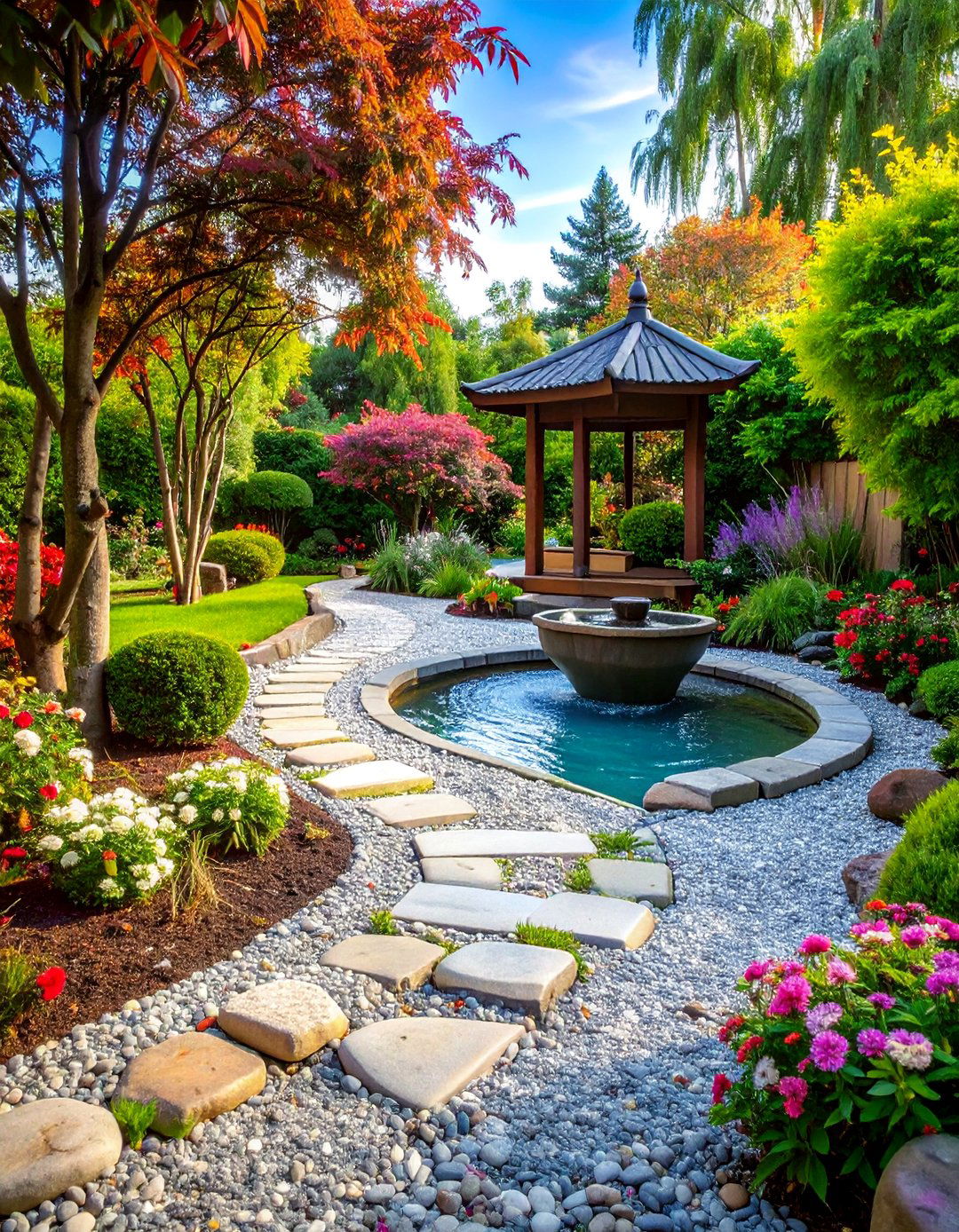
This luxurious design incorporates small water features such as bubbling fountains or narrow water channels alongside pea gravel pathways. Water features can be added around Zen garden elements to enhance the peaceful, contemplative atmosphere. The sound of moving water creates tranquil ambiance while the visual element adds sophistication and cooling effects during warm weather. Simple recirculating fountains, shallow rills, or decorative bubblers can be integrated into pathway design without major complexity. The water features should be positioned to complement pathway flow while providing visual and auditory interest. This design creates resort-like atmosphere in residential gardens while maintaining practical pathway function. Appropriate drainage ensures water features don't interfere with pathway stability while seasonal shutdown considerations should be planned for colder climates where freezing occurs.
18. Traditional English Garden Pea Gravel Walkway with Rose Borders
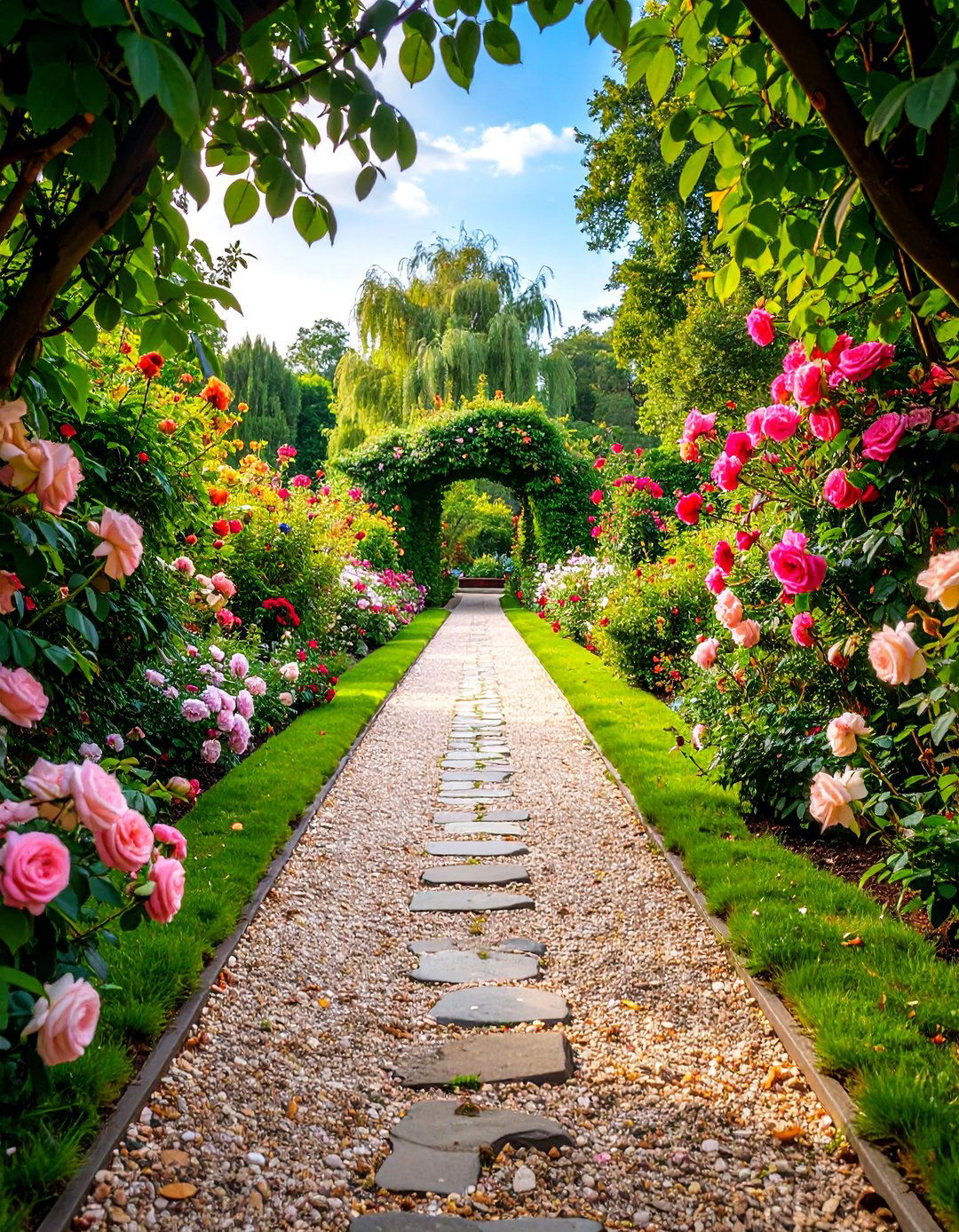
This classic design captures the essence of traditional English gardens through rose plantings that border elegant pea gravel pathways. Formal rose gardens can be enhanced with pea gravel surfaces that provide practical access while highlighting beautiful plantings. Various rose types including hybrid teas, shrub roses, or climbing varieties can be used depending on space and style preferences. The neutral tones of pea gravel provide perfect backdrop for colorful rose blooms while offering practical, all-weather walking surfaces. Traditional edging materials like brick or natural stone complement the formal garden aesthetic. This design requires regular rose maintenance including pruning, fertilizing, and disease management, but rewards gardeners with spectacular seasonal displays. The combination of aromatic roses and textured gravel creates sensory-rich garden experiences that embody classic English garden traditions.
19. Modern Geometric Pea Gravel Walkway with Steel Planters
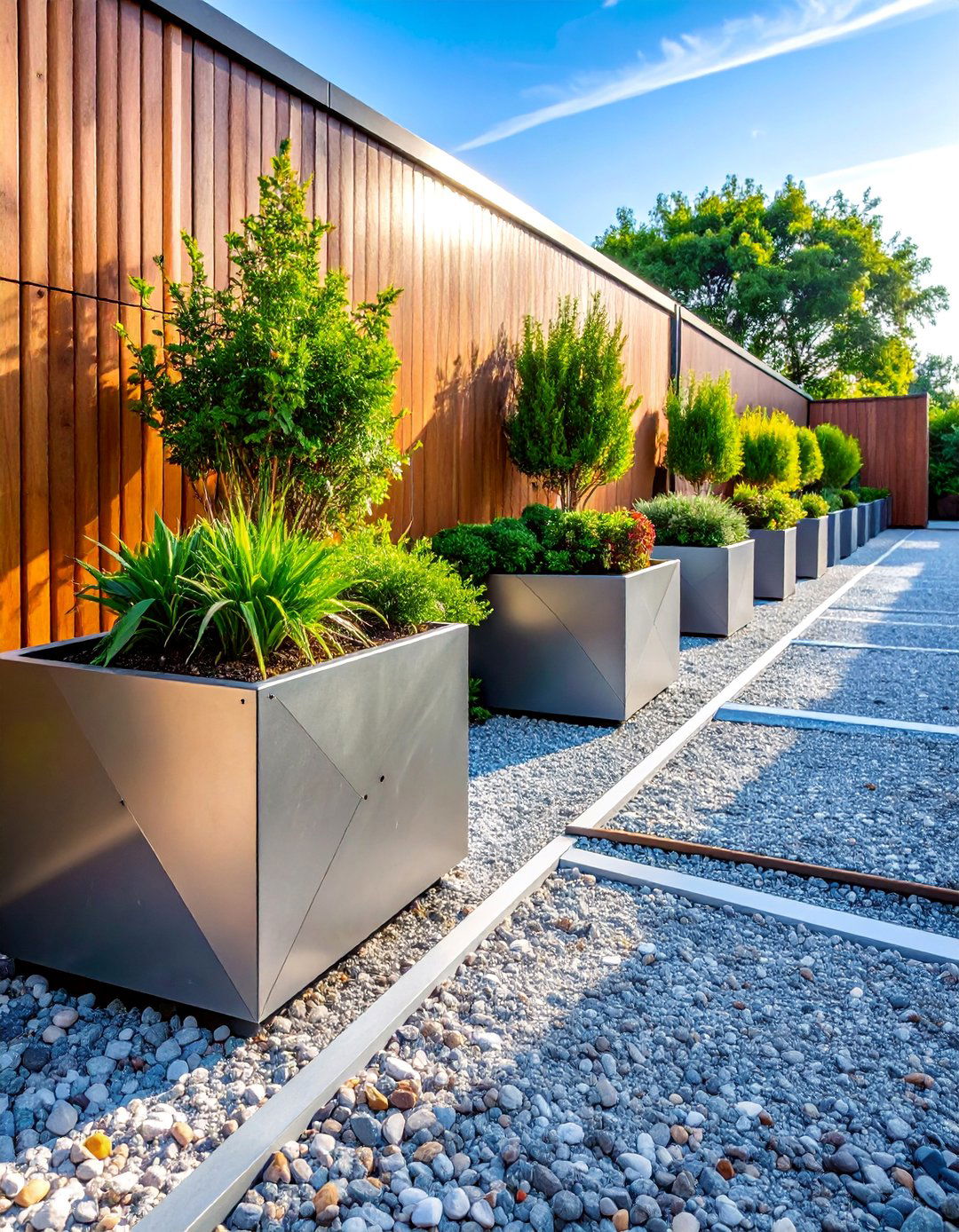
This contemporary design features geometric pathway layouts complemented by steel or corten steel planters positioned strategically along the route. Metal edging and components develop attractive weathered appearances over time while providing durable, modern aesthetics. The planters can accommodate architectural plants like ornamental grasses, succulents, or carefully pruned shrubs that enhance the modern design theme. Geometric patterns in the pathway layout create visual interest while maintaining clean, sophisticated appearance. The steel planters provide elevated growing space while their industrial appearance complements contemporary home designs. This style works particularly well with modern, industrial, or minimalist architectural styles where clean lines and metal accents are featured. The combination of metal and gravel textures creates sophisticated contrast while requiring minimal maintenance once established.
20. Pea Gravel Walkway with Seasonal Container Gardens
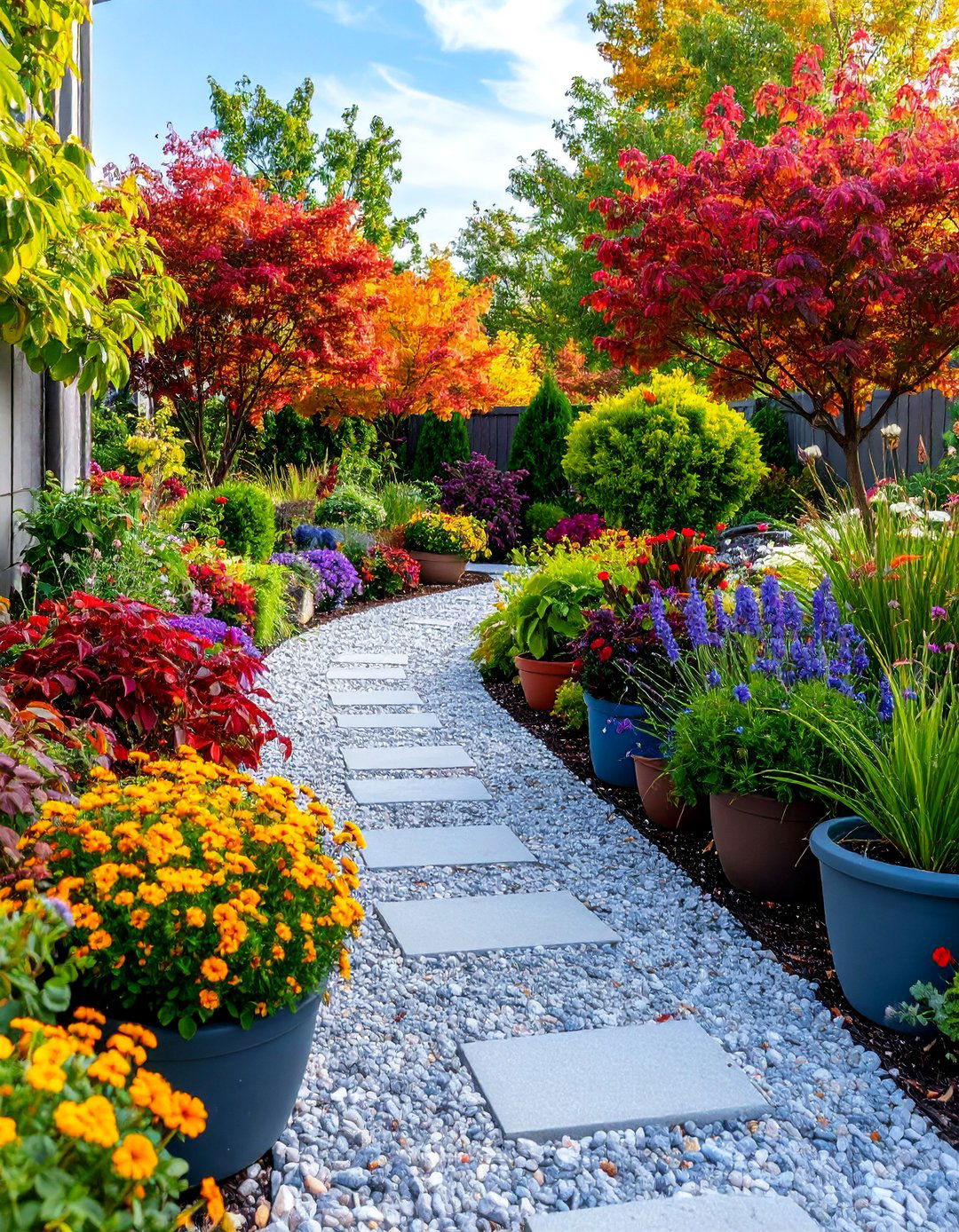
This flexible design incorporates moveable container gardens positioned along pea gravel pathways to provide seasonal color and interest that can be changed throughout the year. Container plants can benefit from pea gravel drainage layers while pathway containers provide seasonal flexibility. Large decorative pots or planters can accommodate seasonal flowers, herbs, vegetables, or specialty plants that provide changing displays. The containers can be repositioned seasonally or replaced entirely to maintain fresh, interesting pathway borders. This approach allows gardeners to experiment with different plant combinations without permanent commitments. The pea gravel surface provides stable bases for containers while excellent drainage prevents water logging issues. This design suits gardeners who enjoy changing displays and experimenting with different plants throughout growing seasons while maintaining beautiful, functional pathways.
21. Rustic Pea Gravel Walkway with Timber Stepping Stones
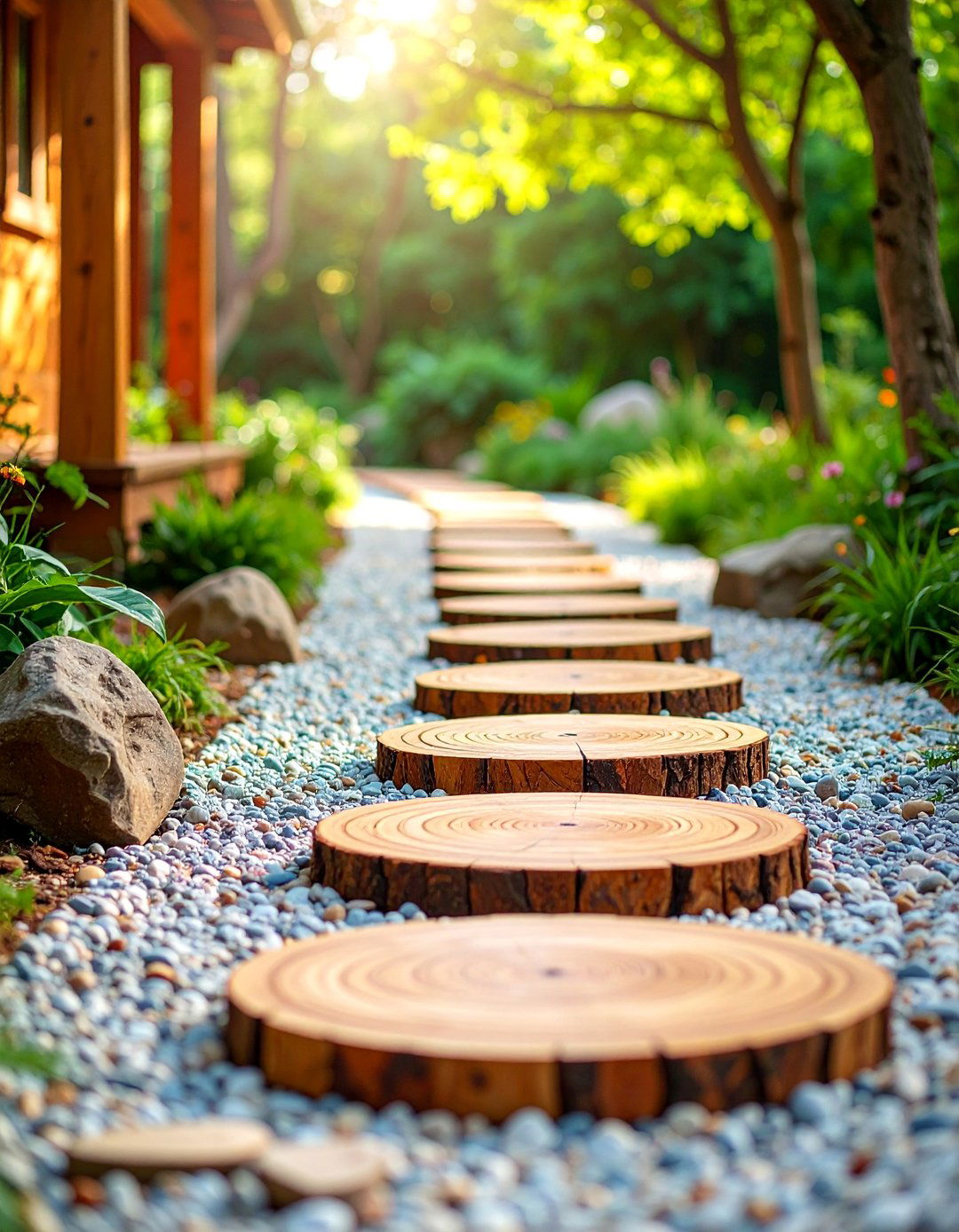
This natural design combines pea gravel surfaces with thick timber rounds or planks used as stepping stones for a rustic, woodland-inspired pathway. Larger stepping stones should be positioned within comfortable walking distances while smaller gravel fills spaces between. The timber stepping stones provide stable footing while the gravel surface offers excellent drainage and natural appearance. Wood species should be chosen for durability and weather resistance, with options including cedar, teak, or pressure-treated lumber. The combination of wood and stone textures creates appealing natural contrasts while maintaining practical pathway function. This style works beautifully in woodland gardens, cabin-style properties, or naturalistic landscape settings. The timber stepping stones can be positioned level with gravel surface or slightly raised for additional definition and visual interest.
22. Formal Symmetrical Pea Gravel Walkway with Topiary Accents

This elegant design features symmetrical pathway layouts complemented by carefully maintained topiary plantings that provide formal structure and year-round interest. Topiary and dwarf conifers work well in Zen-style gardens while providing structure and formal appearance. Common topiary plants include boxwood, yew, or holly shaped into spheres, cones, or more complex geometric forms. The symmetrical design creates formal garden elegance while pea gravel provides practical, all-weather walking surfaces. Regular topiary maintenance including shaping and trimming is required to maintain crisp, formal appearance. This design suits traditional, formal, or estate-style garden settings where elegance and sophistication are desired. The combination of shaped plantings and neutral gravel surfaces creates timeless appeal that complements classical architecture and formal landscape designs.
23. Pea Gravel Walkway with Native Plant Rain Gardens

This environmentally conscious design incorporates native plant rain gardens positioned alongside pea gravel pathways to manage stormwater while creating habitat for local wildlife. Pea gravel provides excellent drainage properties that complement rain garden functionality. Native plants selected for local climate conditions require minimal maintenance while providing seasonal interest and ecological benefits. The rain garden areas can handle overflow water from nearby roofs or paved surfaces while the pea gravel pathways provide stable access through planted areas. This design combines practical stormwater management with beautiful, functional landscapes. Native plants support local pollinators and wildlife while requiring fewer inputs than non-native alternatives. The combination of practical drainage, environmental benefits, and attractive design makes this approach ideal for environmentally conscious homeowners seeking sustainable landscape solutions.
24. Multi-Level Pea Gravel Walkway with Retaining Walls
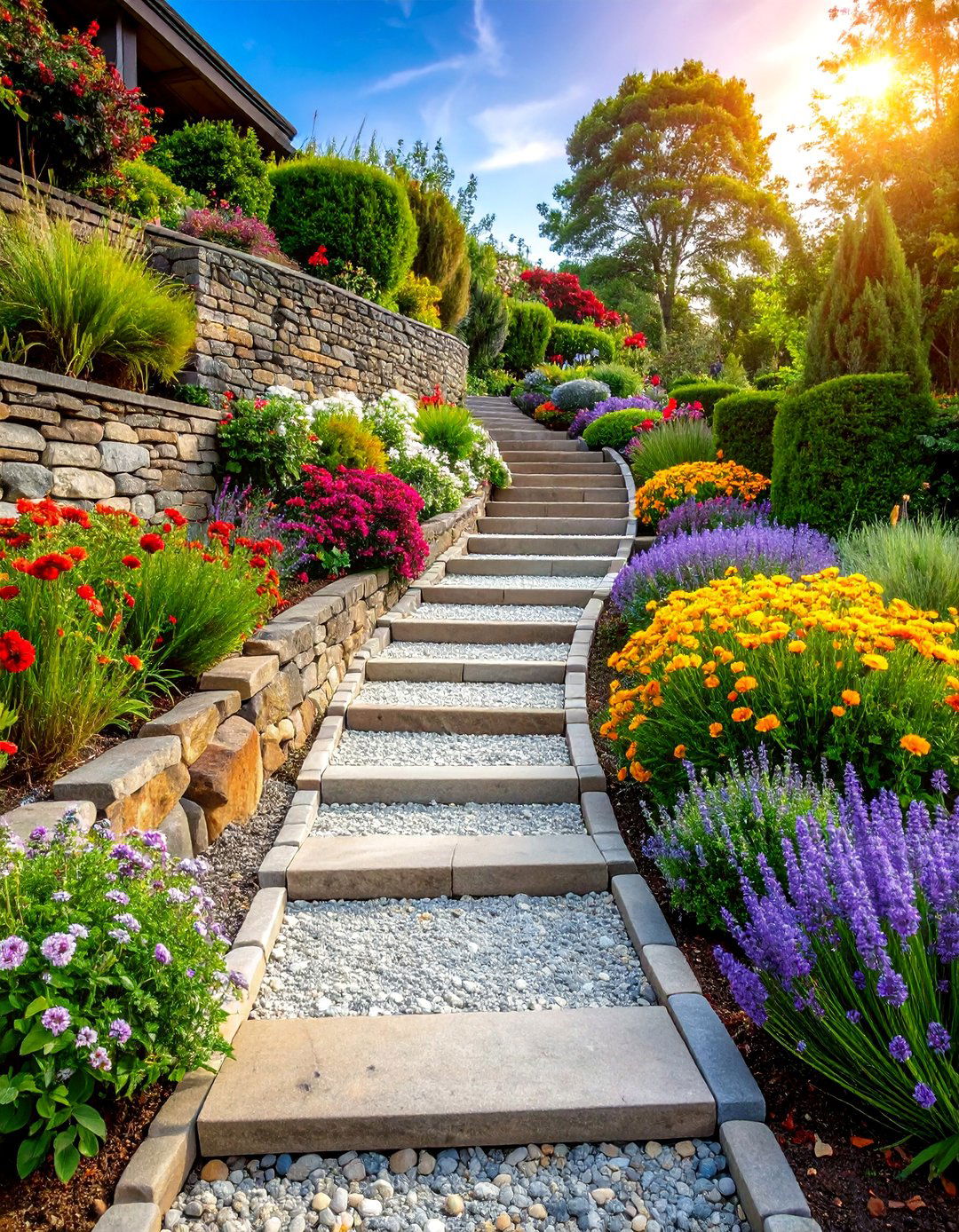
This sophisticated design accommodates sloped terrain through terraced levels connected by pea gravel pathways and supported by attractive retaining walls. Stone walls can form terraces that work with natural topography while providing level pathway surfaces. The retaining walls can be constructed from natural stone, concrete blocks, or pressure-treated timber depending on style preferences and budget considerations. Each level provides flat walking surfaces while the overall design follows natural slope contours. This approach transforms challenging sloped sites into functional, attractive garden spaces with accessible pathway systems. Plantings can be incorporated into terraced areas while gravel pathways provide stable connections between levels. This design requires careful drainage planning and professional installation for structural stability, but creates dramatic, functional landscapes that maximize usable space on sloped properties.
25. Therapeutic Sensory Pea Gravel Walkway with Aromatic Plants
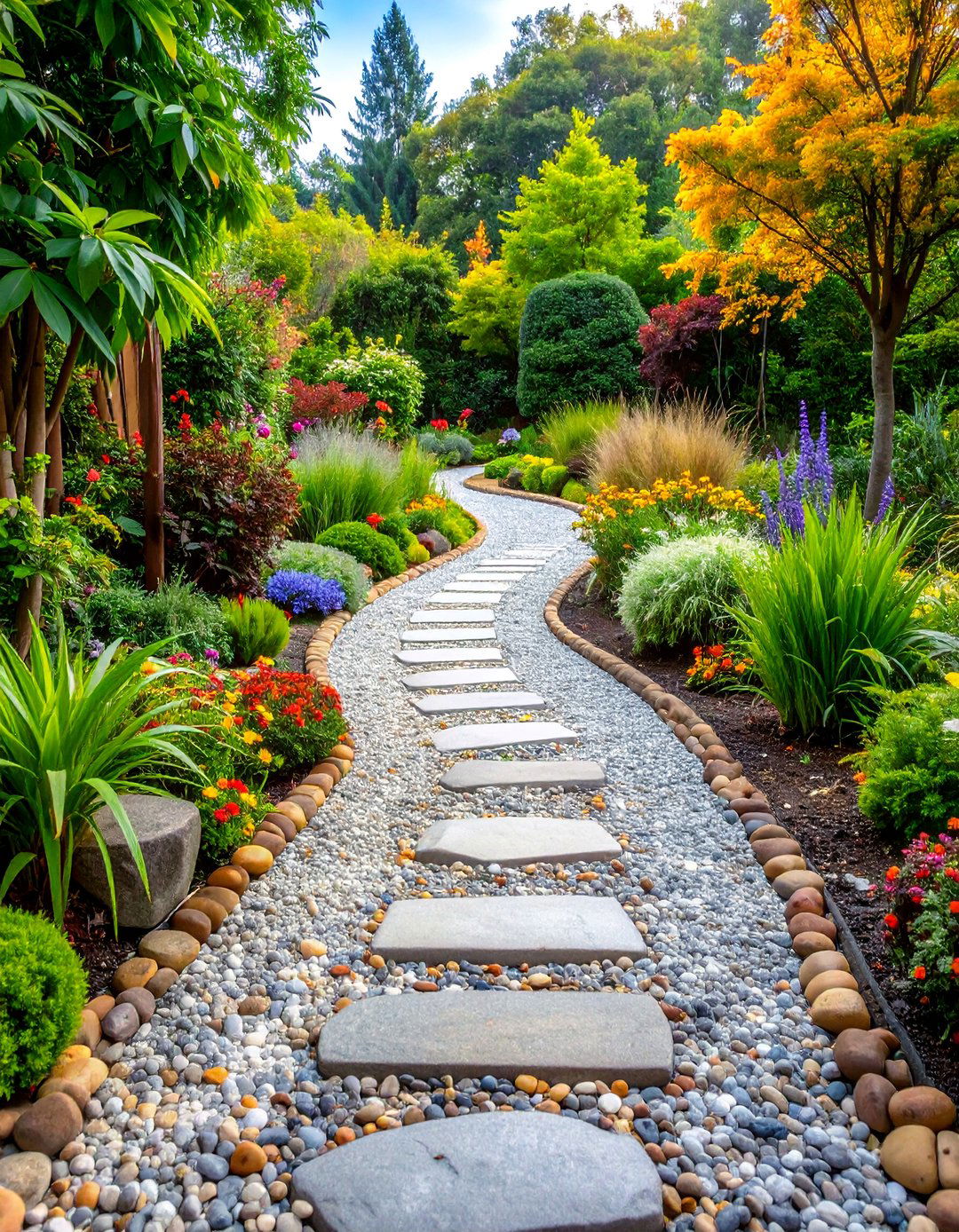
This specialized design focuses on sensory experiences through aromatic plantings and varied textures that create therapeutic, healing garden environments. Fragrant plants like lavender or catmint provide sensory experiences while complementing neutral gravel tones. The pathway incorporates different gravel textures, aromatic plants, and tactile elements that engage multiple senses for therapeutic benefits. Plants might include lavender, rosemary, mint, or other aromatic species that release fragrance when touched or disturbed by breezes. Varied gravel sizes create different walking experiences while maintaining accessibility for users with mobility challenges. This design suits healthcare facilities, therapeutic gardens, or home gardens designed for relaxation and stress reduction. The combination of textural, aromatic, and visual elements creates multi-sensory experiences that promote wellbeing and mindful awareness of natural environments.
Conclusion:
Pea gravel walkways offer endless possibilities for creating beautiful, functional pathways that enhance any landscape design. From traditional cottage garden styles to modern zen-inspired layouts, these versatile materials accommodate diverse aesthetic preferences while providing practical benefits including excellent drainage, low maintenance requirements, and weather resistance. Whether incorporating natural stone edging, aromatic plant borders, or integrated water features, pea gravel pathways can be customized to reflect personal style while serving essential circulation functions. The combination of affordability, design flexibility, and durability makes pea gravel an excellent choice for creating lasting pathway solutions that improve with age and provide years of beautiful, functional garden access.


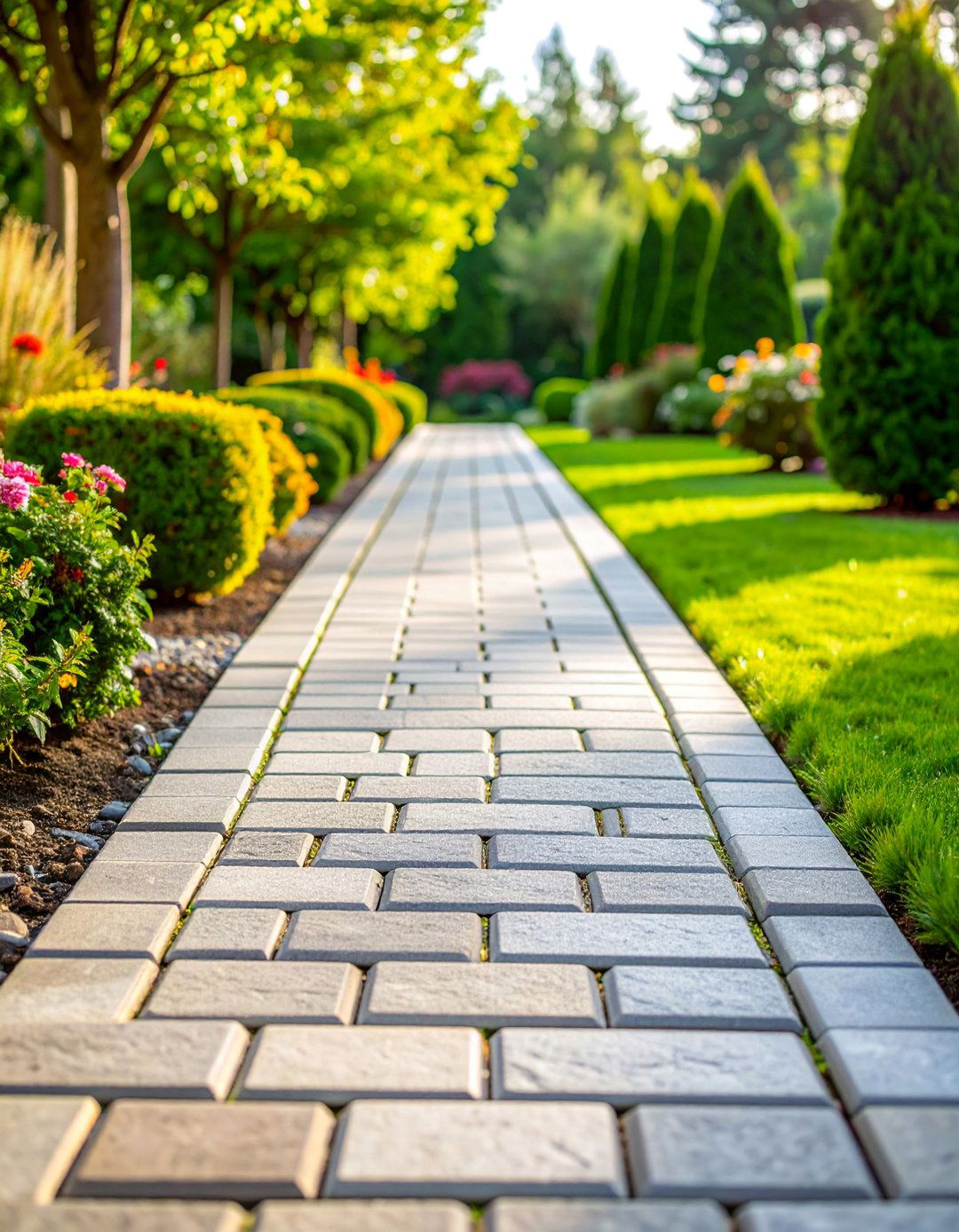
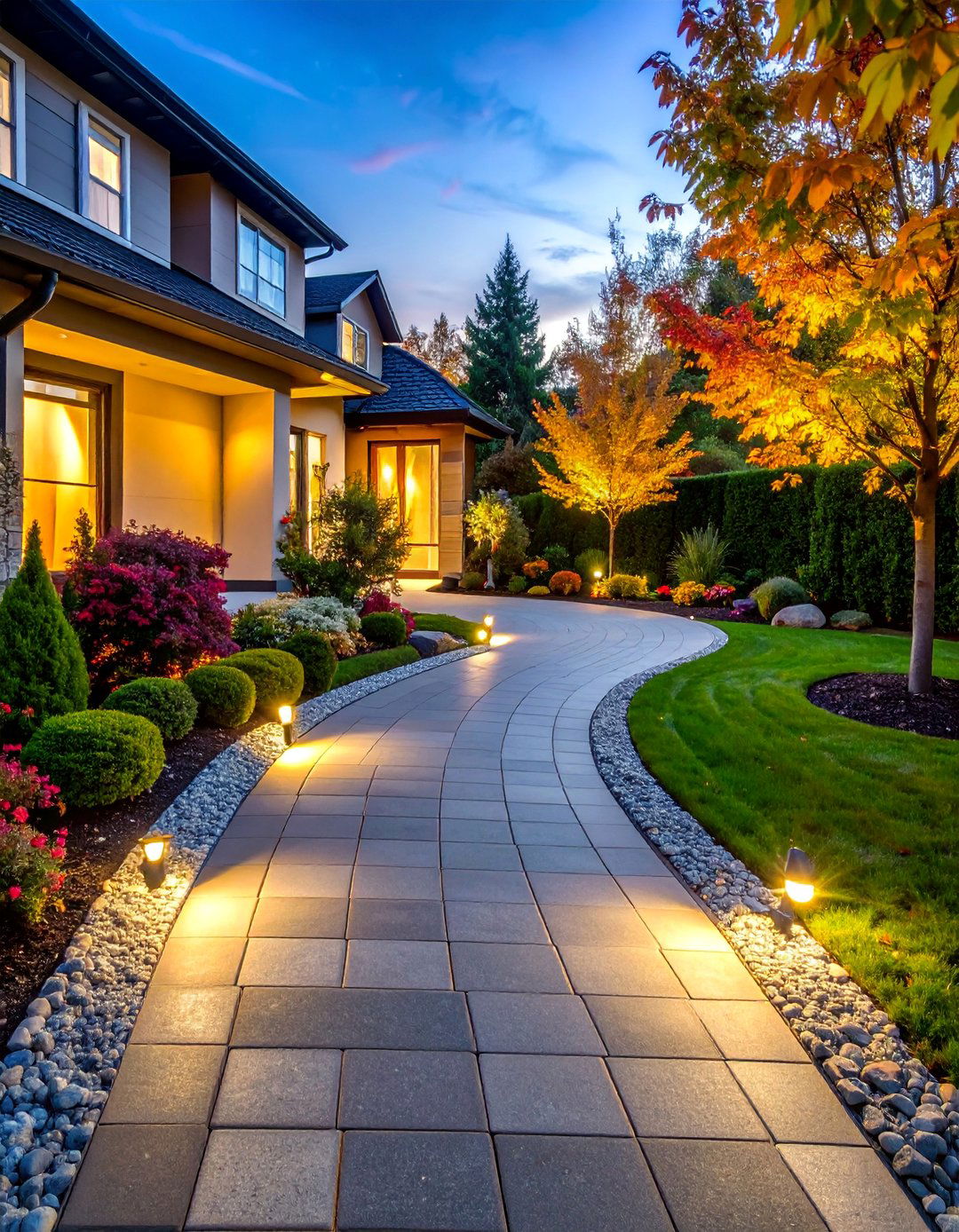
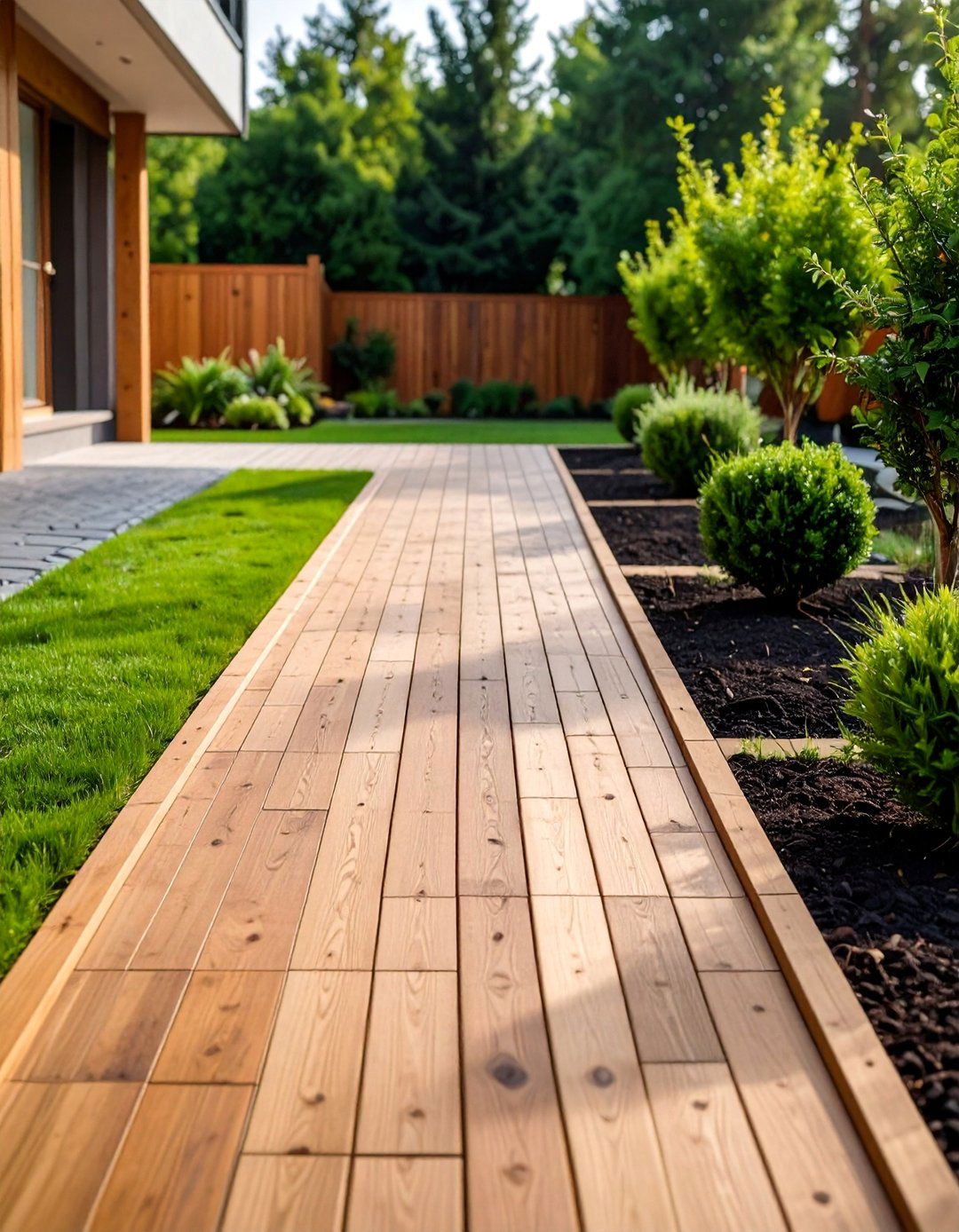


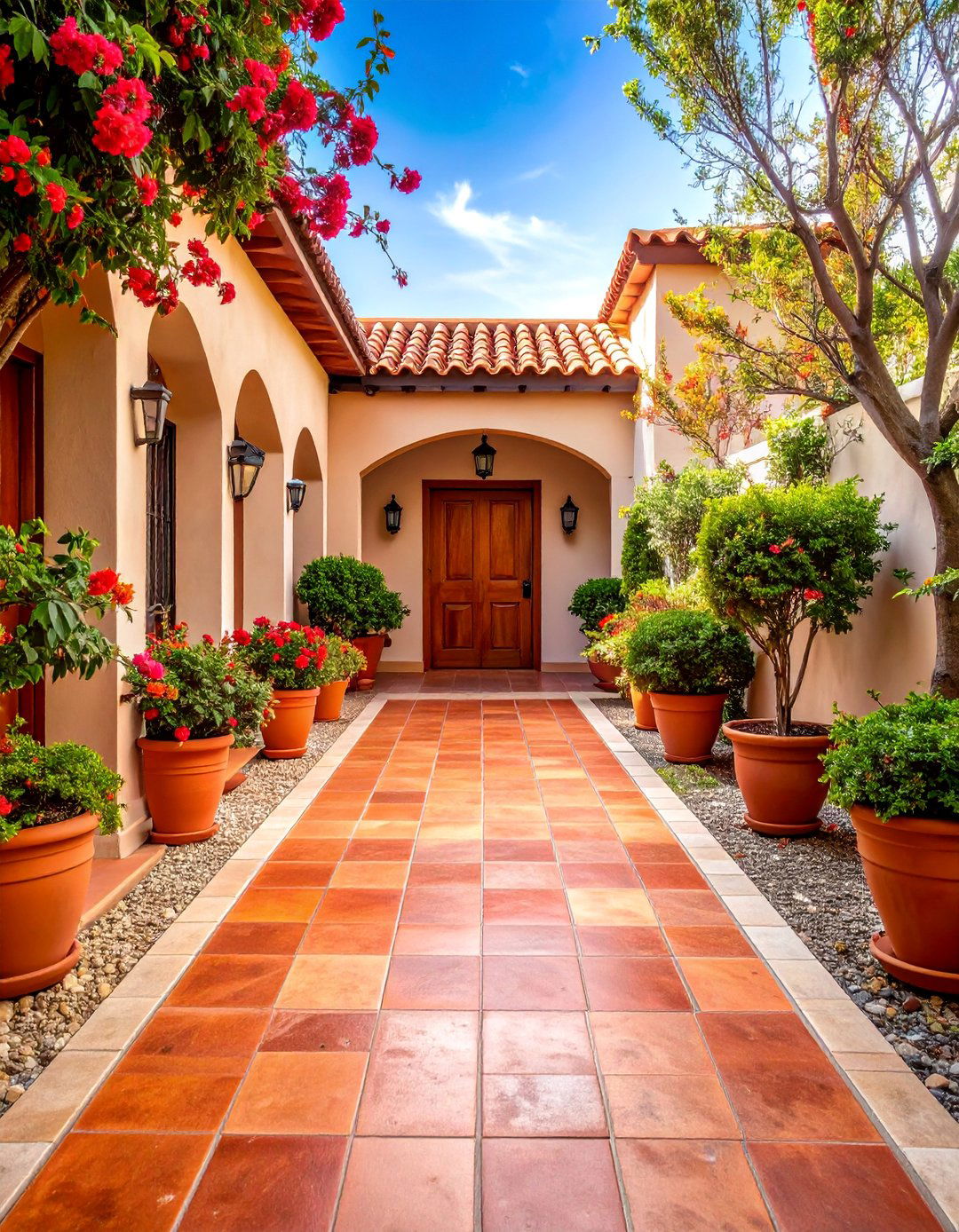


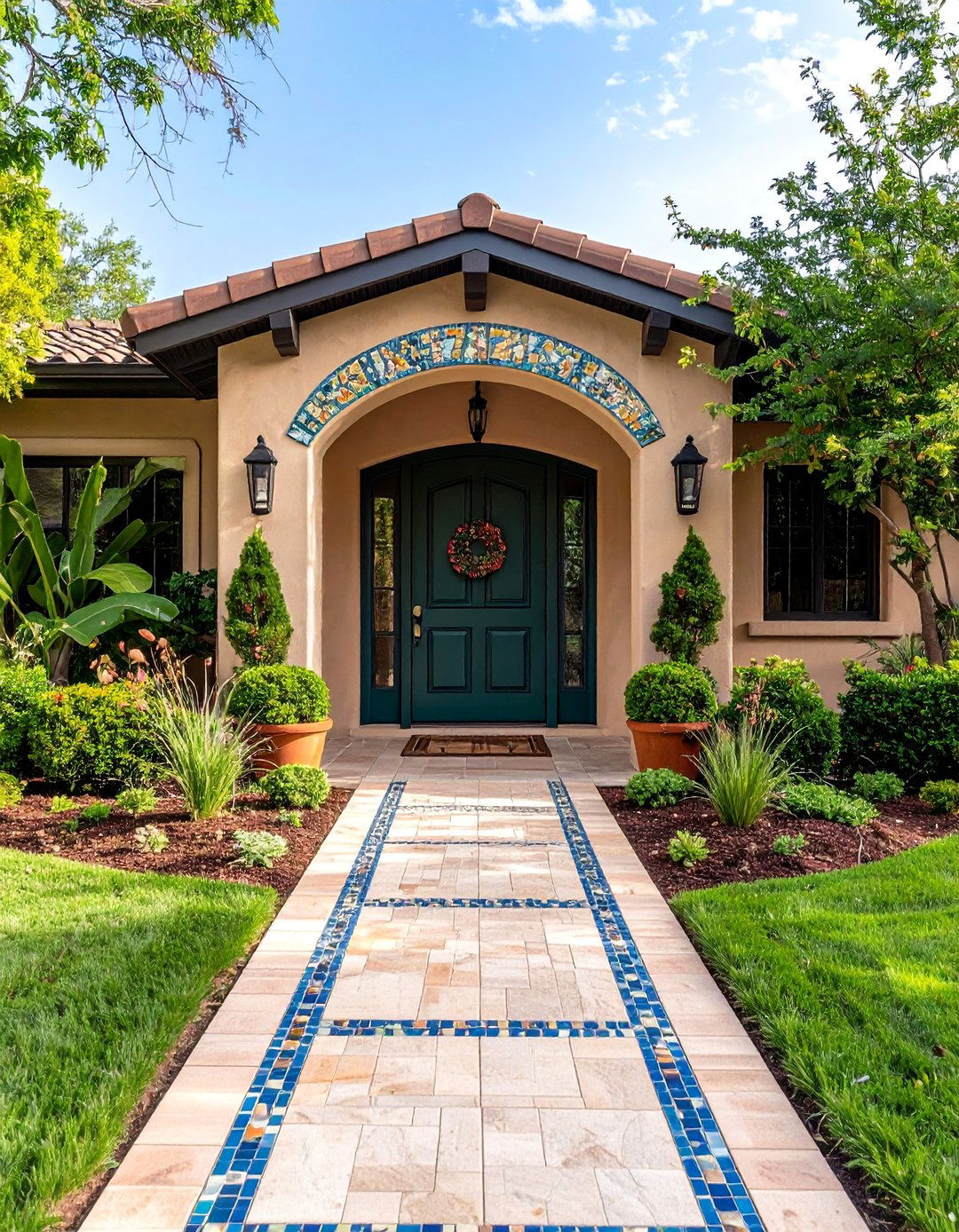
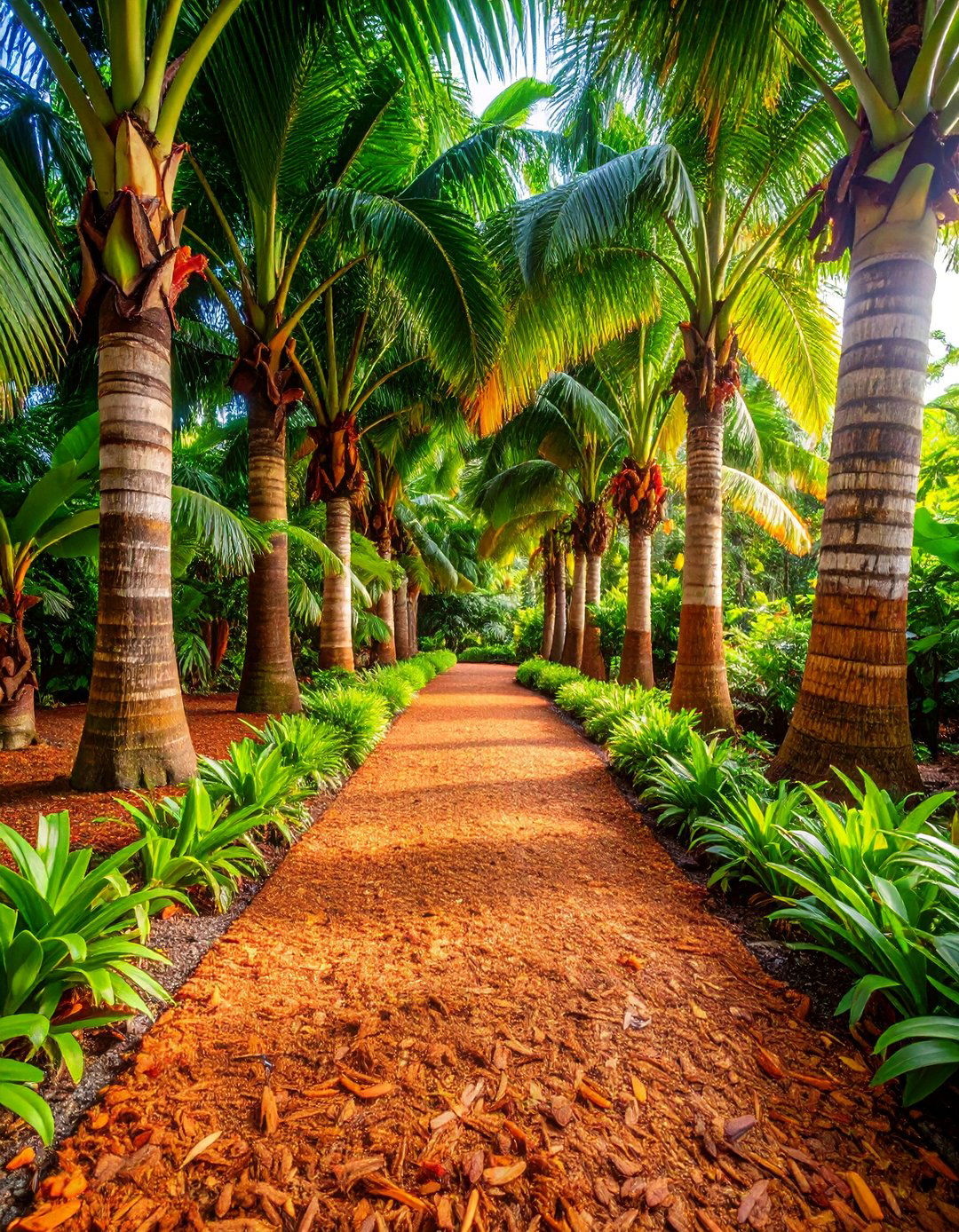
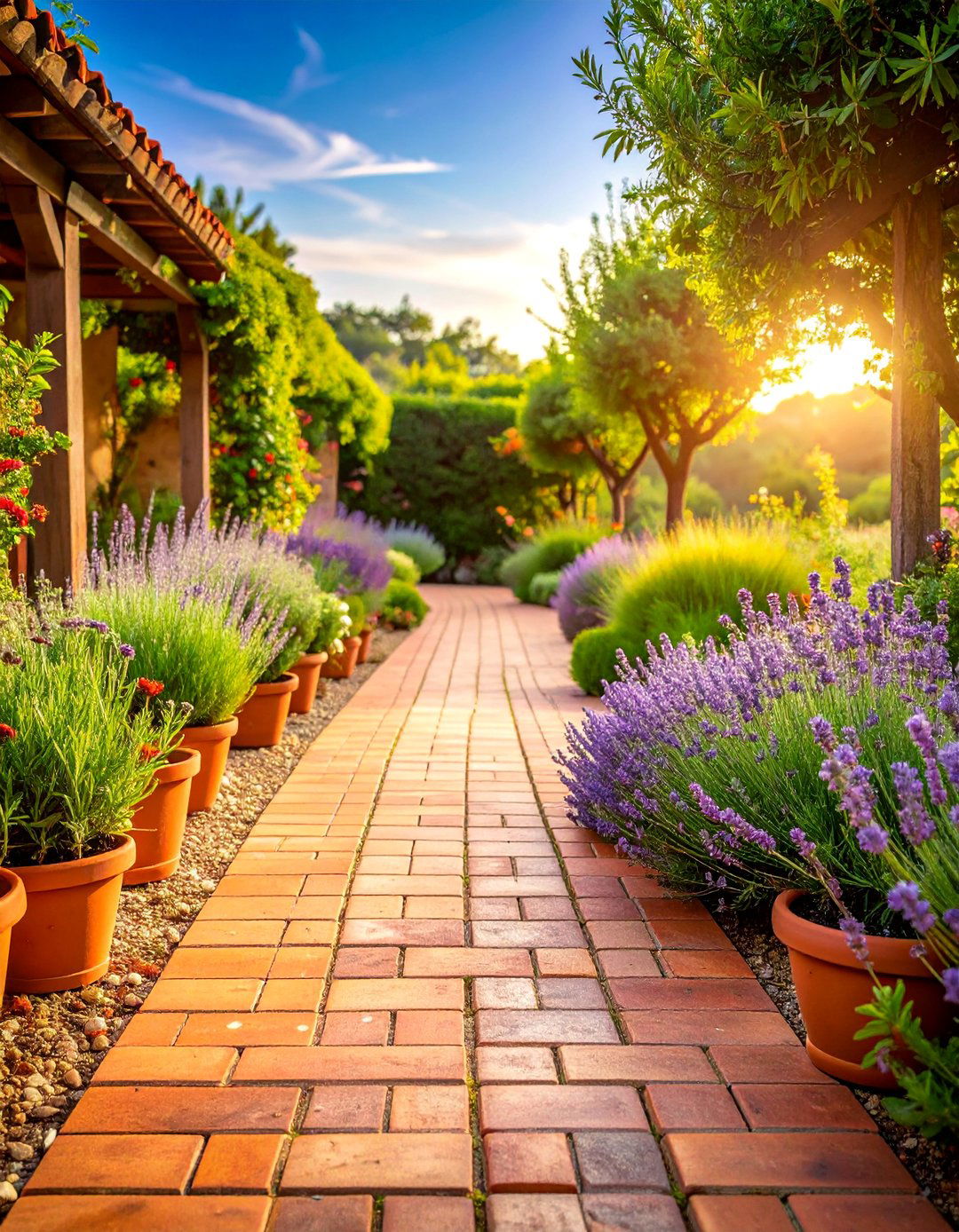
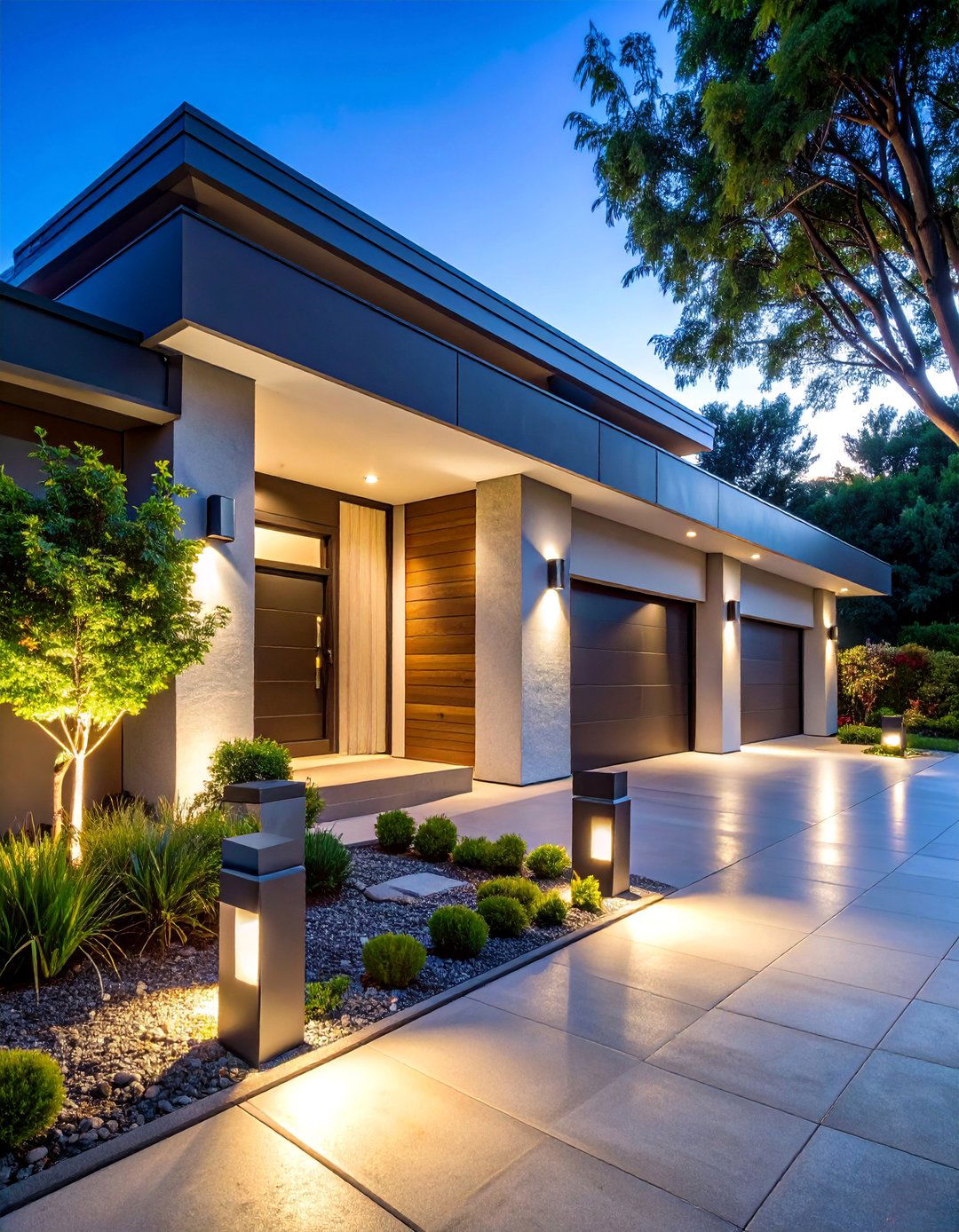

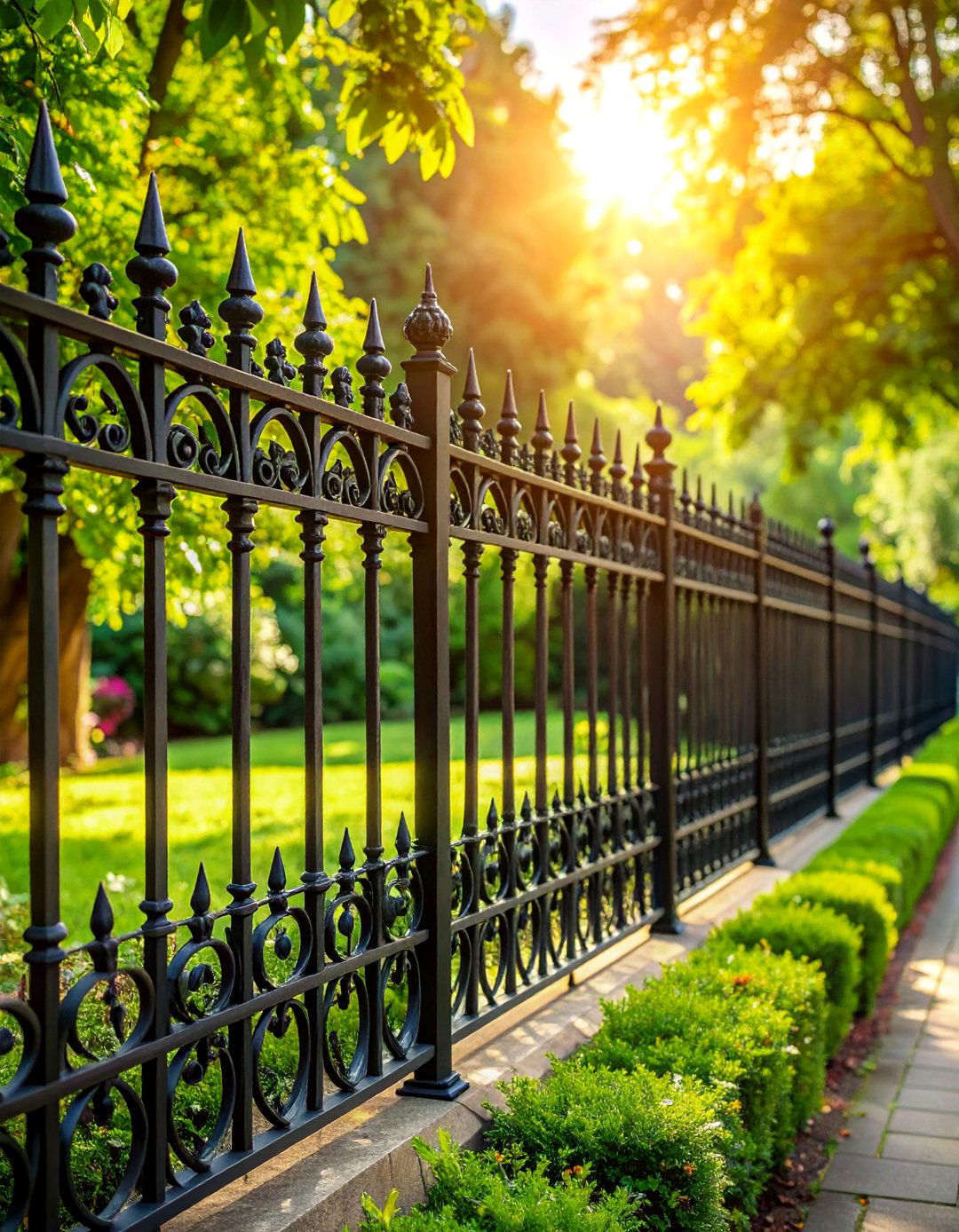


Leave a Reply